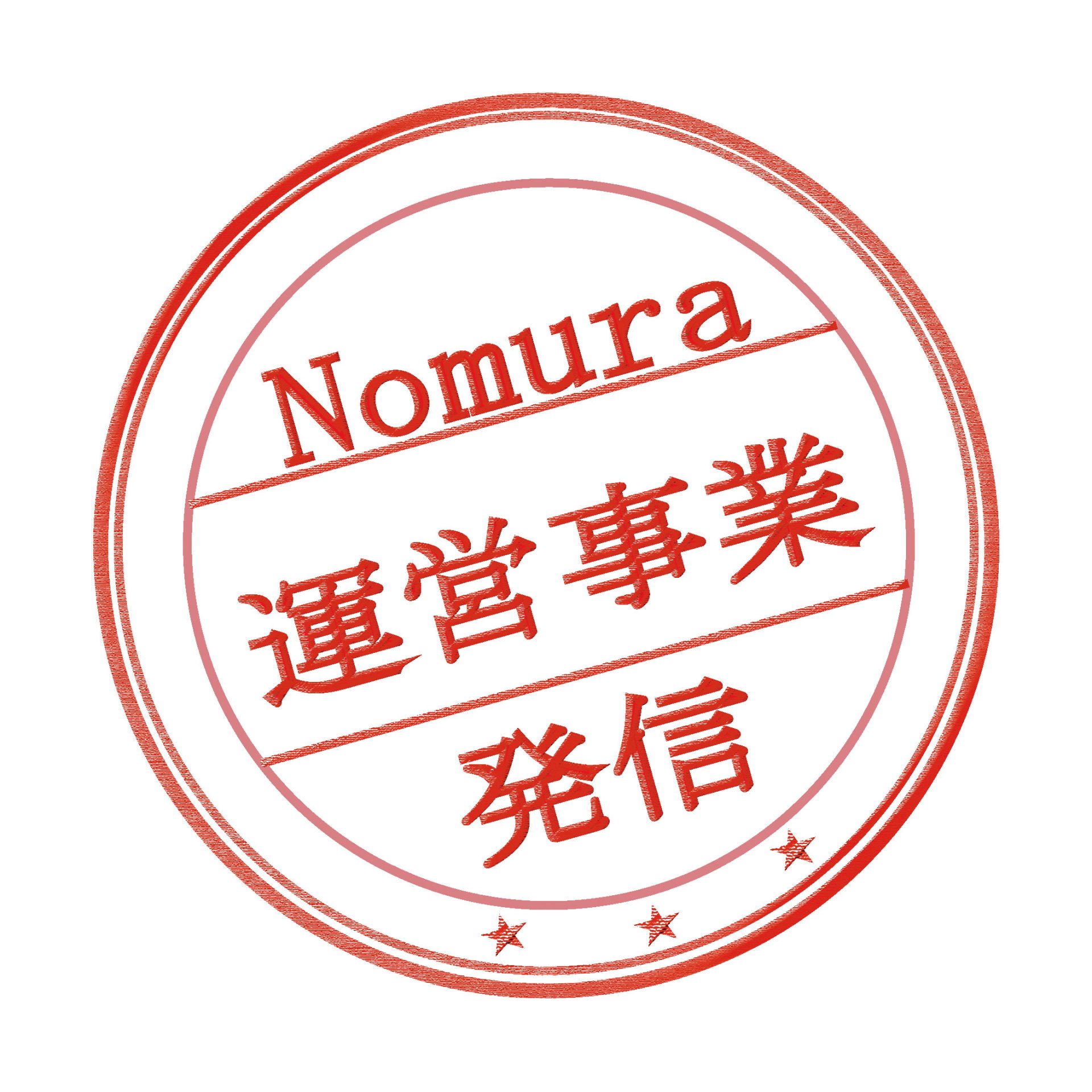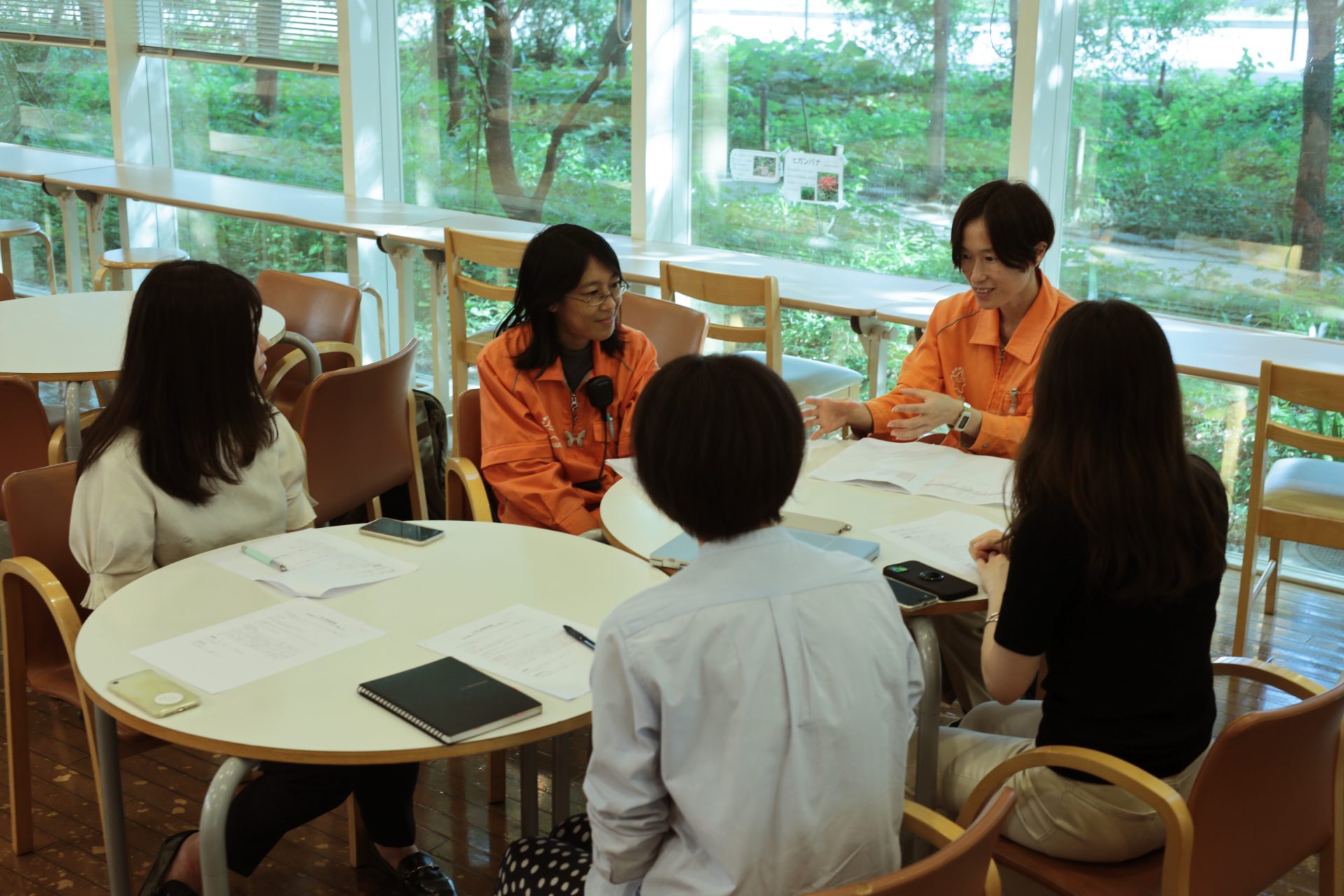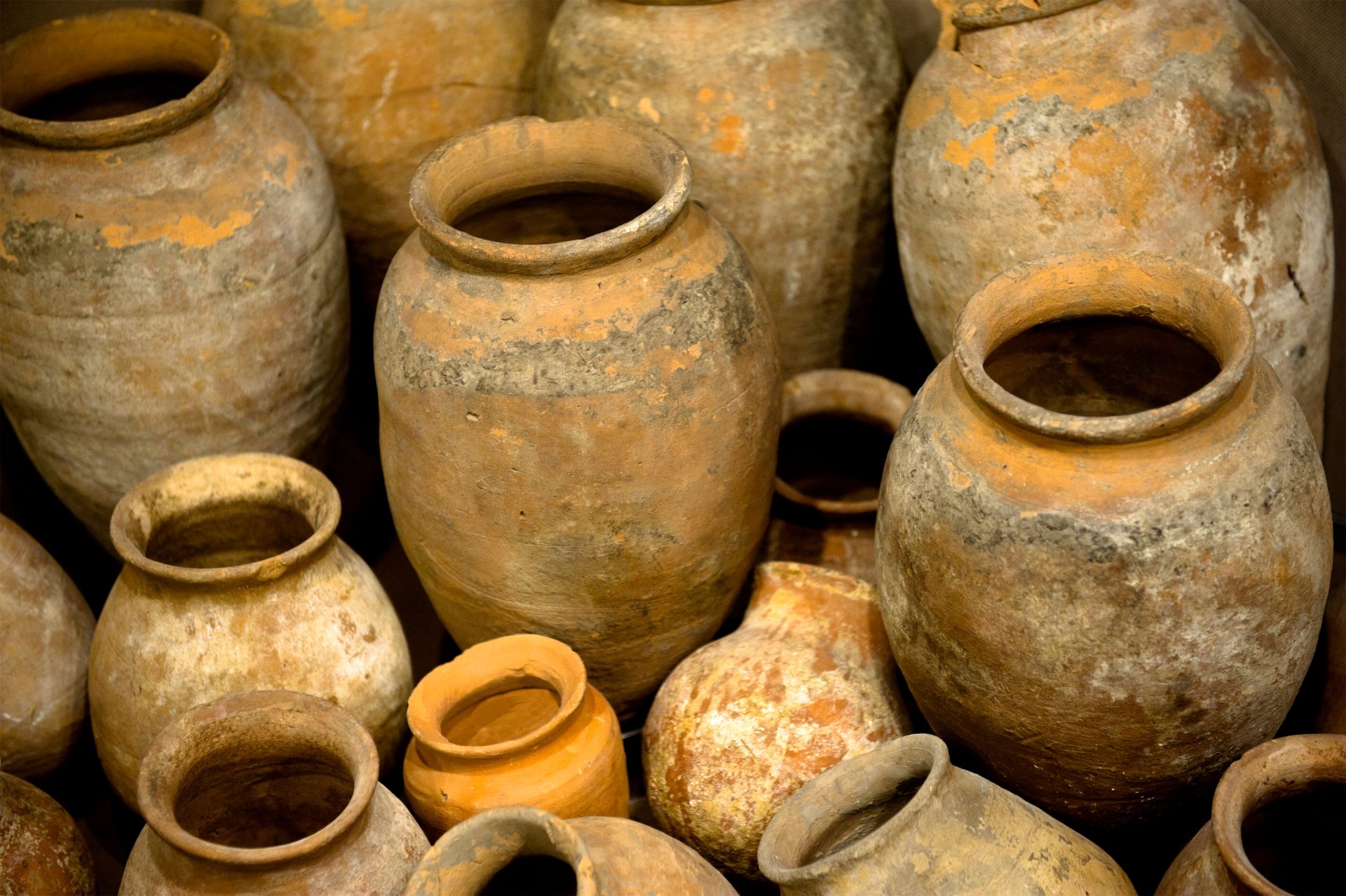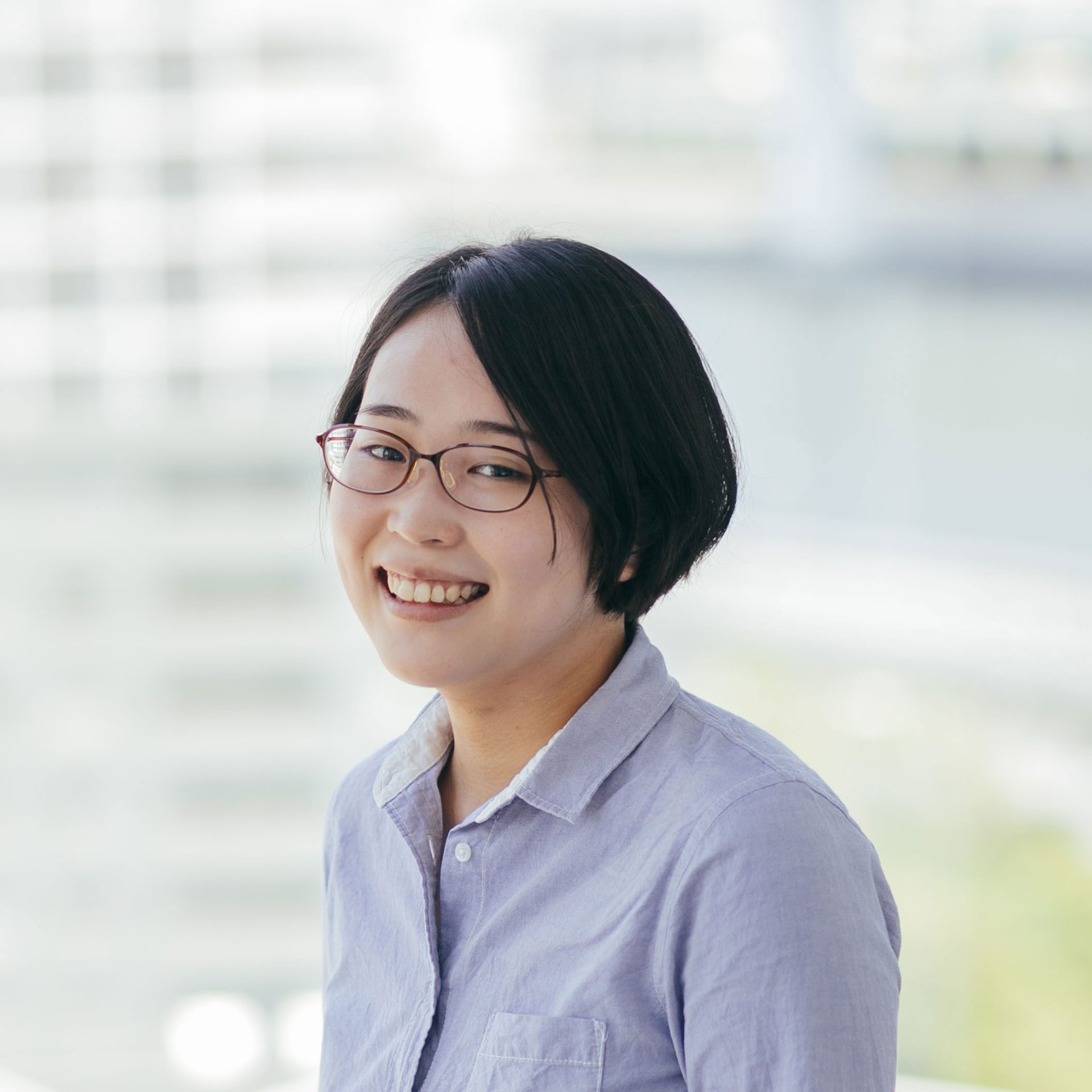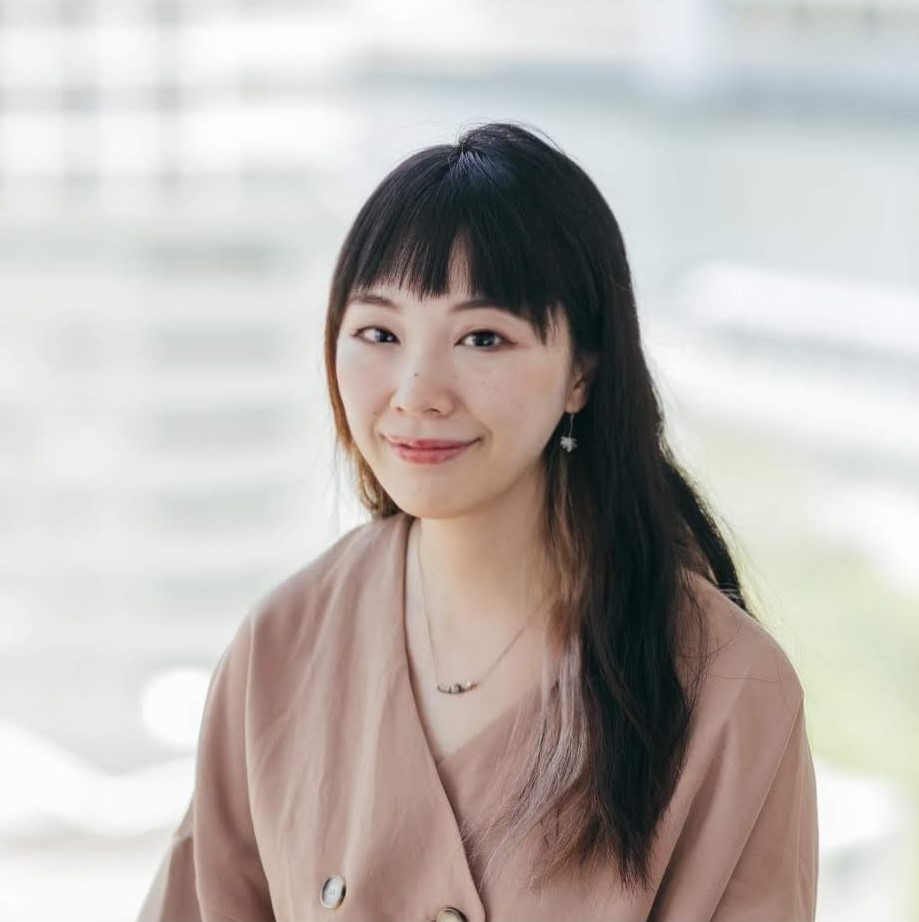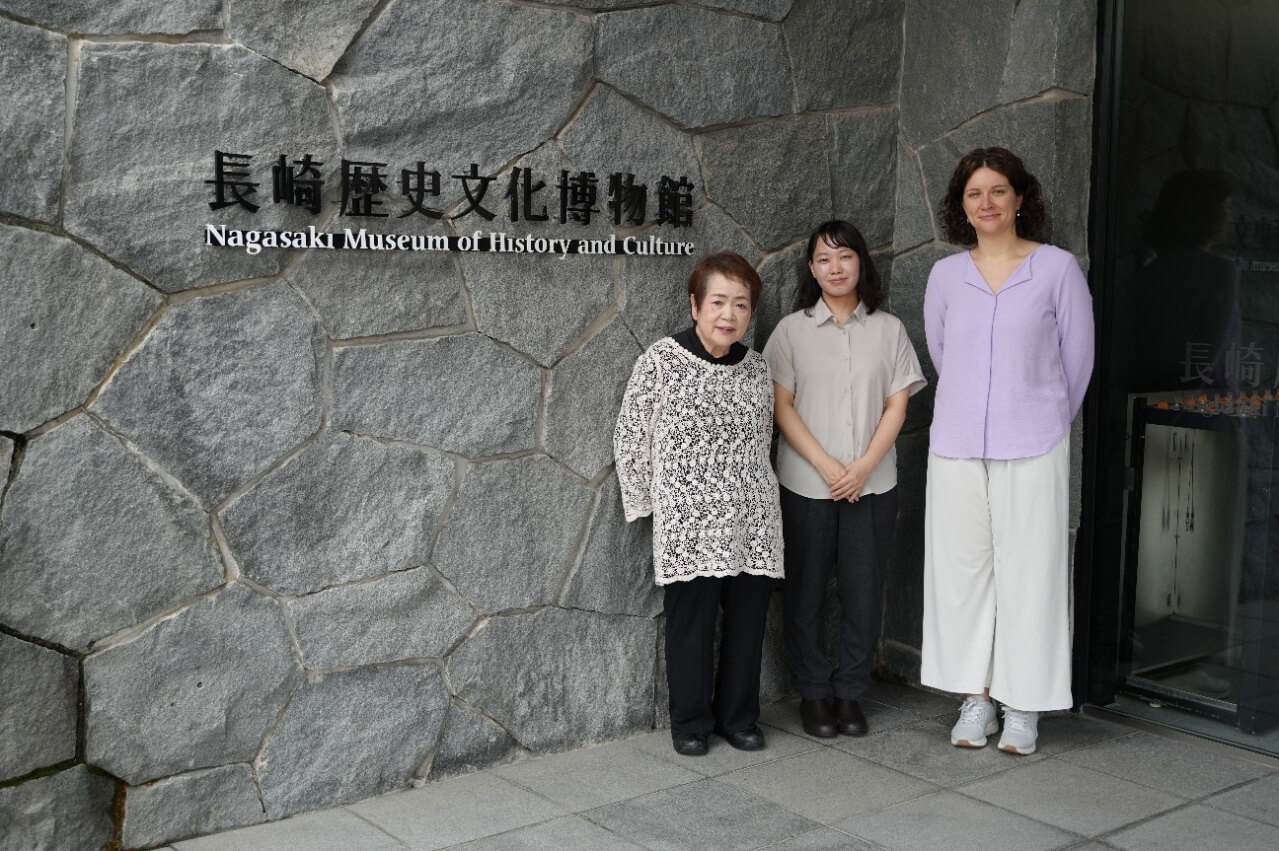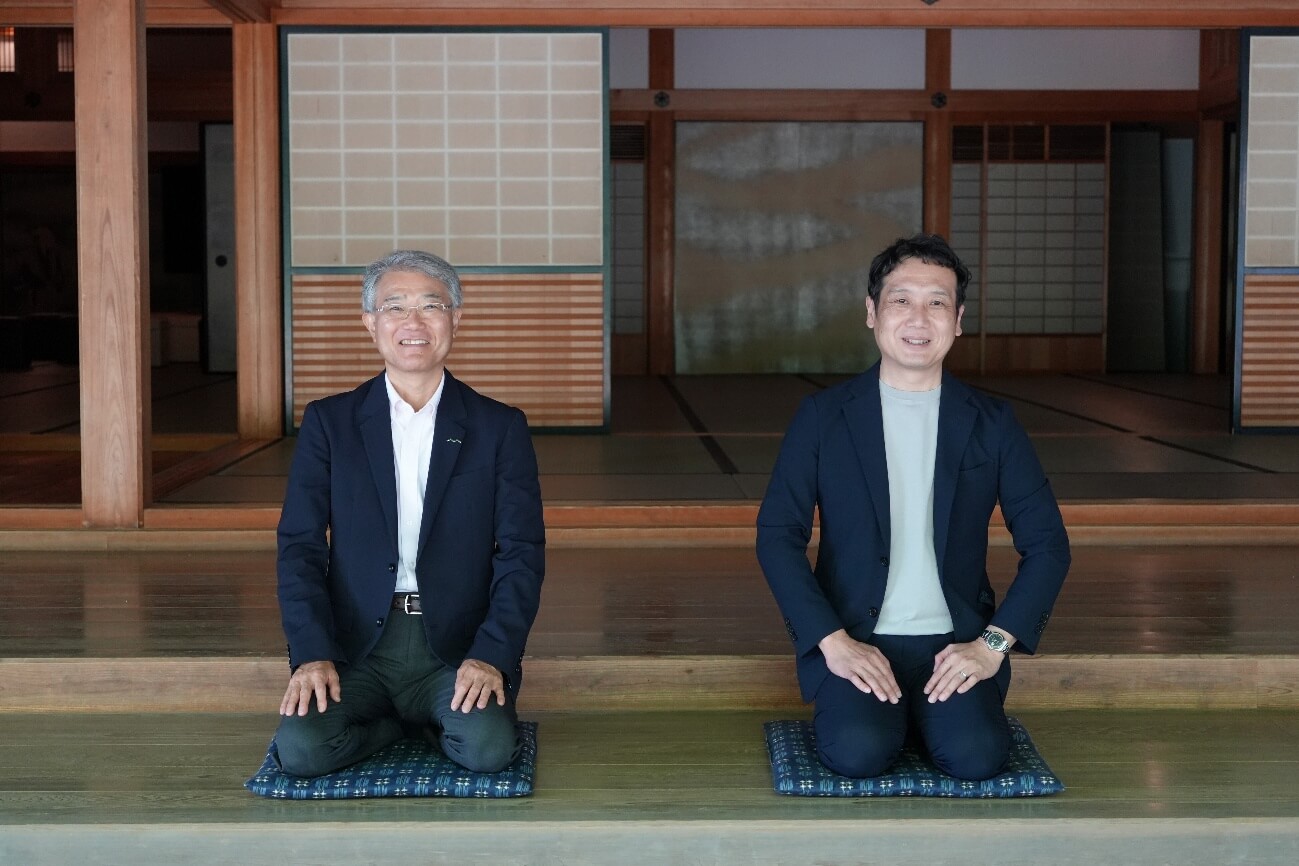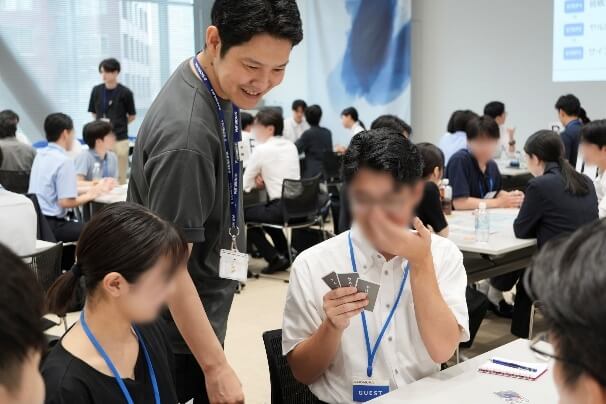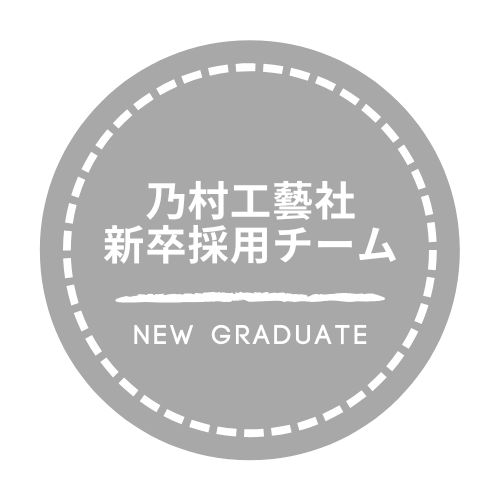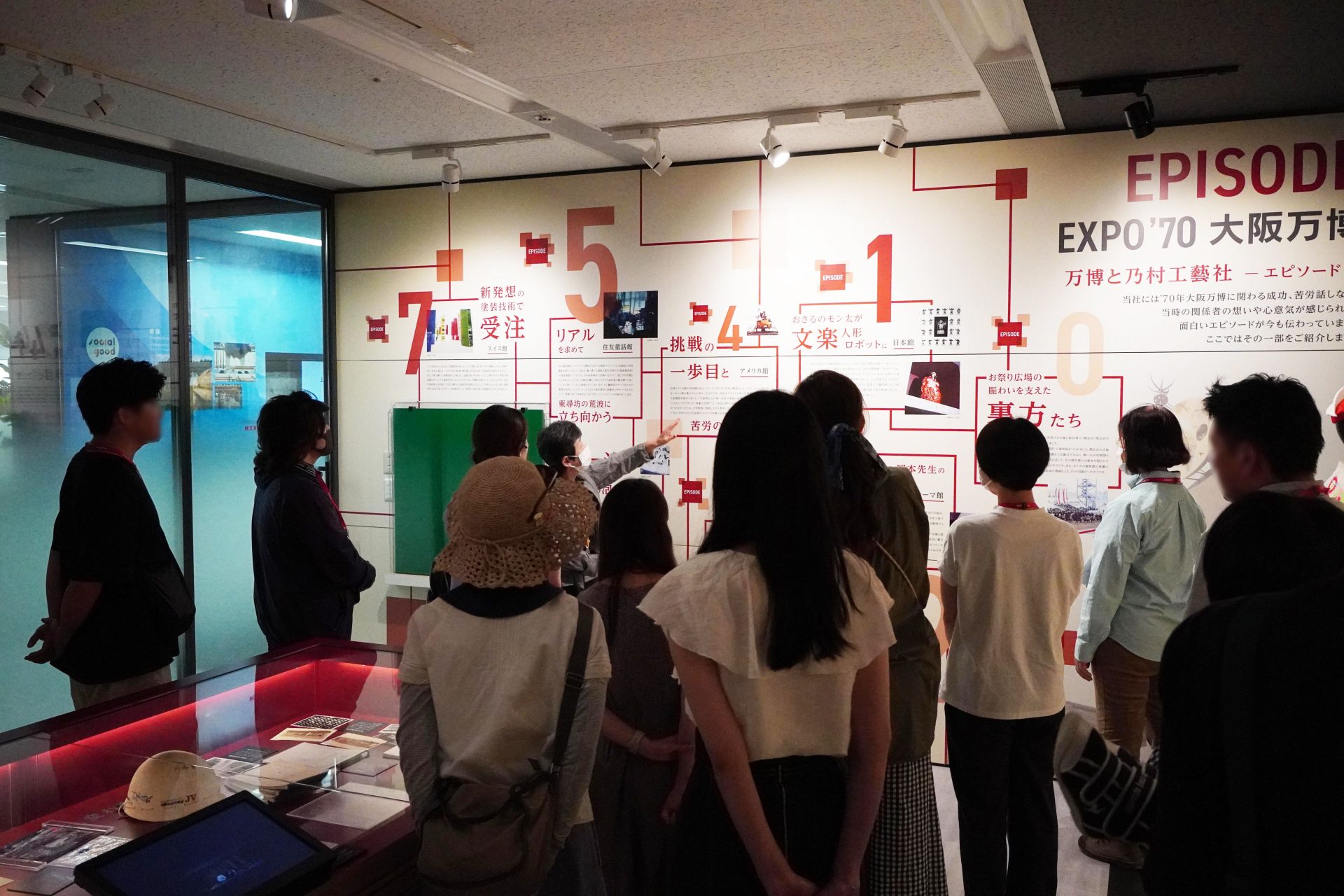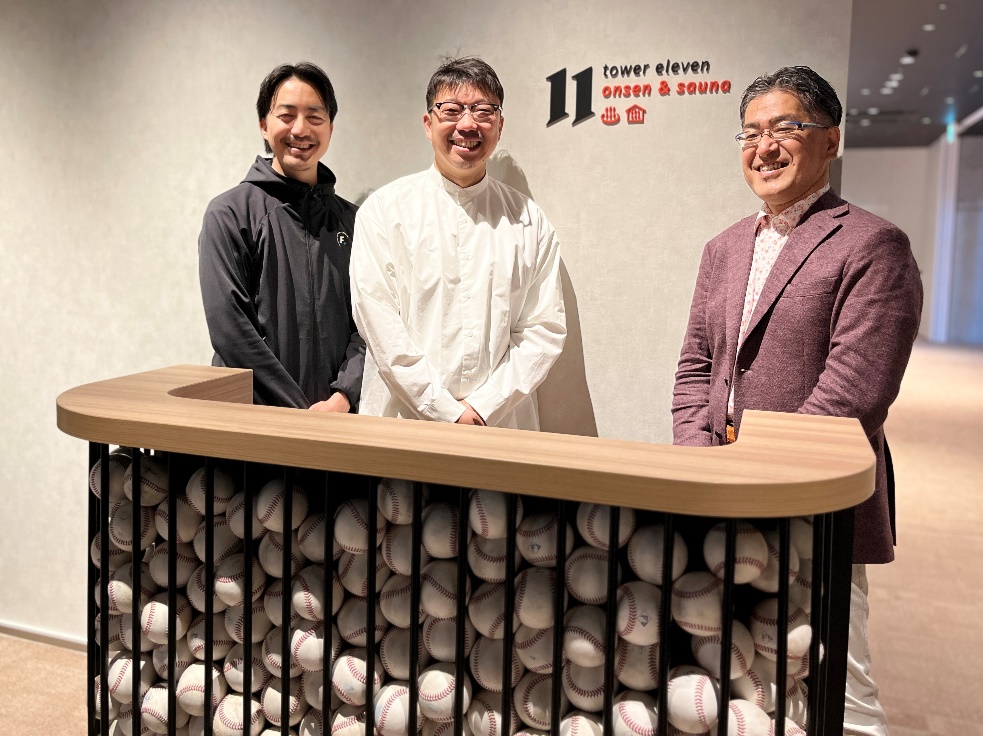
- text and edit by
- 乃村工藝社 施設運営事業
乃村工藝社グループは総合空間プロデュース企業として、空間の設計・施工だけでなく、開業後の施設の運営も手掛けており、ビジネスプロデュース本部 運営事業課では、博物館、科学館、美術館などの文化施設を中心に、調査研究・学芸部門を含む、施設全体の総合的・包括的な運営管理を行っています。
施設に所属するさまざまな専門知識を持ったスタッフが、日々、展示テーマをどのような想いで企画し、来館者の皆さんに伝える工夫をしているのか、その独自の視点を切り取るインタビュー記事「企画展のつくり方」をシリーズ化します。
これまでのシリーズ記事:企画展のつくり方 多摩六都科学館 生き物への深いまなざし『ロクト昆虫図鑑』
シリーズ2回目となる今回は、愛知県「高浜市やきものの里 かわら美術館・図書館」に伺ってきました。
対談のお相手は、企画展担当の主任学芸員 井上 あゆこさん、企画展の関連イベントや地域・学校連携などを担当される杉谷 紬さんです。

【学芸員】
高浜市やきものの里 かわら美術館・図書館
井上 あゆこさん(写真前列右)
企画展担当 主任学芸員 専門分野:日本画、陶磁器 研究テーマ:陶磁器の絵付け、犬山焼
杉谷 紬さん(写真前列左)
美術館の教育普及業務、イベント、地域・学校連携等担当
【インタビュアー】
株式会社乃村工藝社
ビジネスプロデュース本部 第一統括部 公民連携プロジェクト開発1部 運営事業課
森 美樹(写真後列中央)プランニングディレクター
日野 夏香(写真後列右)
青木 莉沙(写真後列左)
*文:岡﨑 広子(ノムログ編集部)
*撮影:伊藤 雄飛(ノムログ編集部)
日本で唯一 「瓦」がテーマの美術館・図書館
日本一の瓦生産量を誇る三州瓦の中心地、高浜市。1995年、旧・高浜市やきものの里かわら美術館は日本で唯一の「瓦」をテーマとした美術館として開館しました。
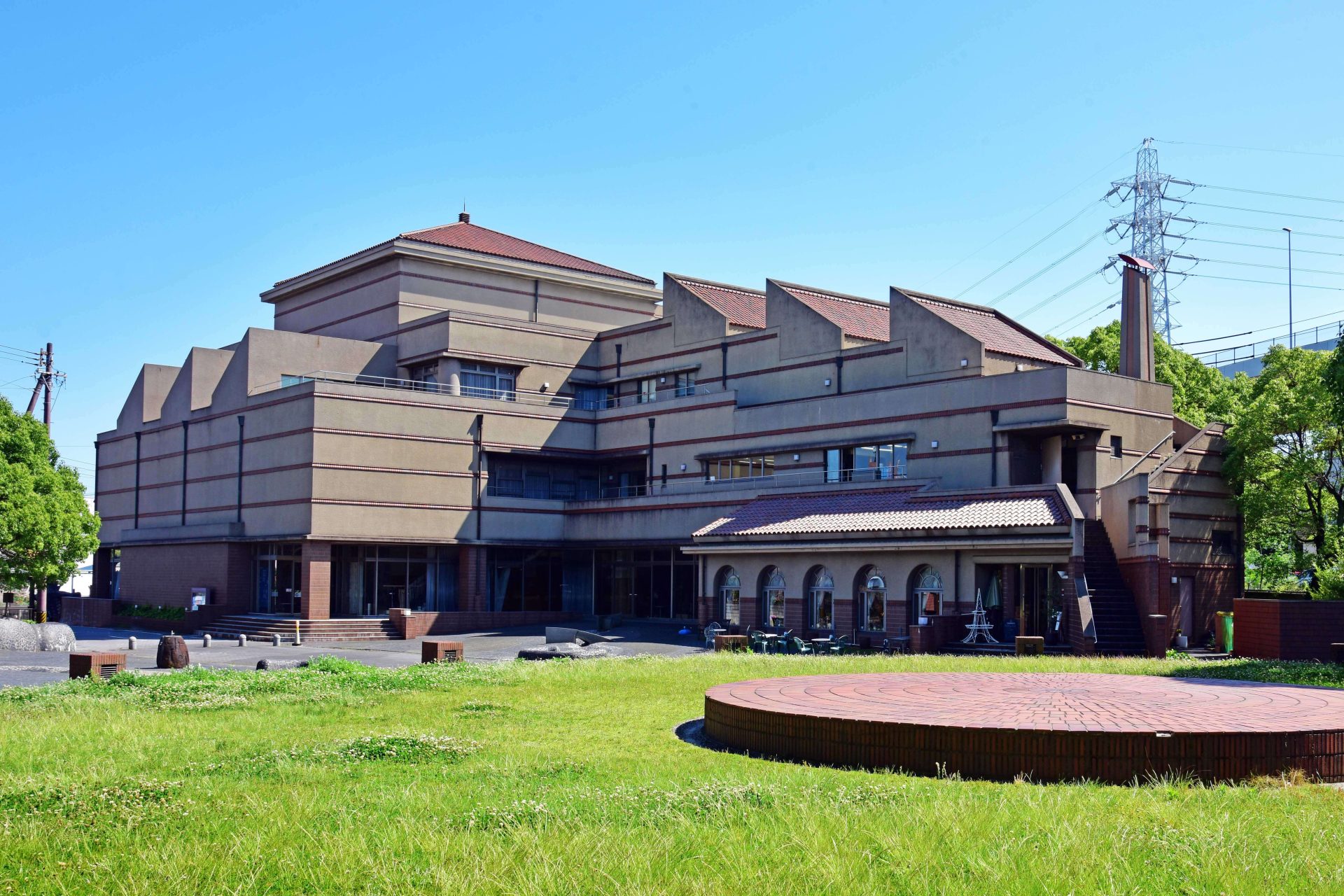 *かつて瓦を運んでいた千石船をモチーフとした外観
*かつて瓦を運んでいた千石船をモチーフとした外観
2023年より市立図書館の機能移転に伴い、図書施設の運営も複合され、「高浜市やきものの里かわら美術館・図書館(以下、かわら美術館・図書館)」となりました。施設には森前公園が隣接し、アートや瓦文化を身近に感じられる美術館と、暮らしによりそう図書館、そこに集う人々の新たな発見や学び、交流を通じ「ひととまちが育つ、つながりの森」となることをコンセプトとしています。
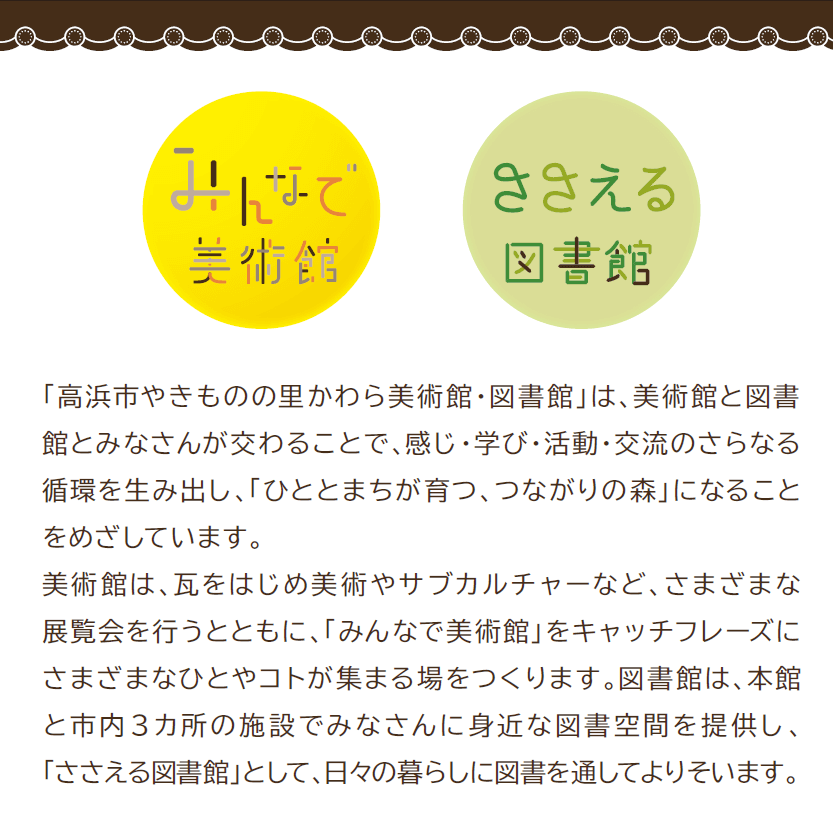
乃村工藝社は、2008年より当館の指定管理業務を受託しており、館長兼統括責任者の若松 文人さんは、乃村工藝社でさまざまな市場のアカウント職を経験後、現職に就任して13年目です。
まずは、インタビューの前に、統括自ら館内をご案内いただきました。

常設展示|1Fロビー展示「たかはま・かわら・三州瓦」
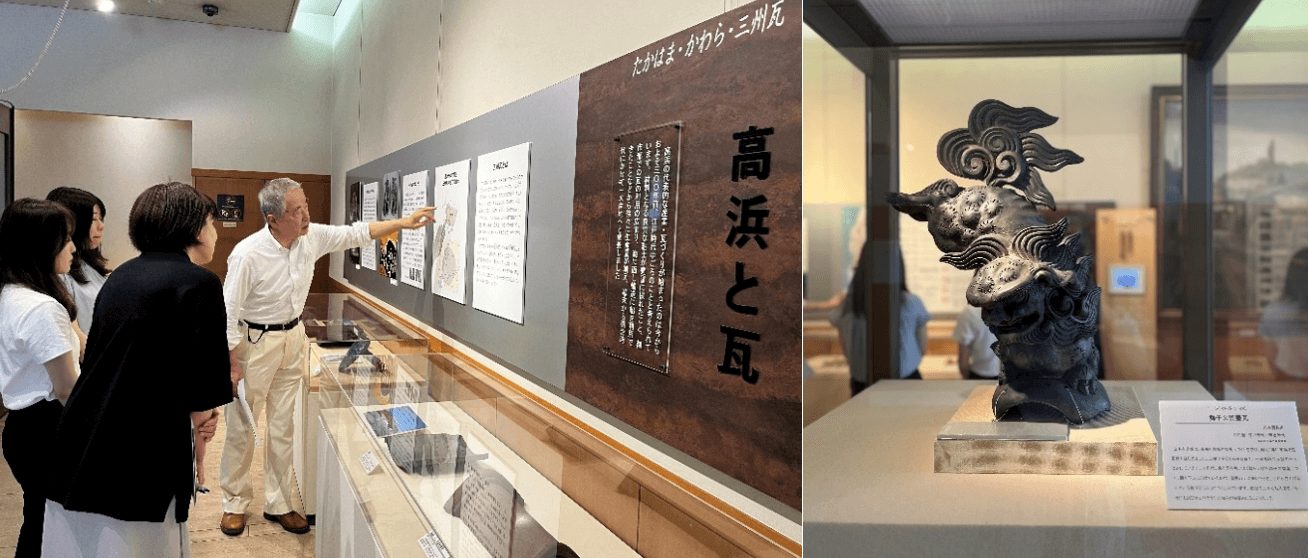
1Fエントランス前のロビーと3F常設ロビーは、若松統括が着任されてから新たな展示空間に。
高浜と瓦の歴史や文化を紹介するコーナーと高浜の鬼師(鬼瓦をつくる職人)の作品が展示され、美術館・図書館への導入口として高浜市と瓦の関係性や歴史・文化への理解が深まります。
かつて高浜市を中心とする三河の地域で瓦に適した粘土が多く取れたことから、江戸時代中ごろより瓦がつくられるようになり、江戸時代後半から昭和にかけて、高浜市は瓦のまちとして発展。現在では、全国で生産される瓦の約7割が三州産とのこと。
高浜港駅からかわら美術館・図書館へ向かう道中にある散策コース「鬼みち」でも、飾り瓦や鬼瓦を見ながら高浜の瓦文化や歴史を垣間見た一同、まちと美術館・図書館の連動性、瓦とのつながりを深く感じました。
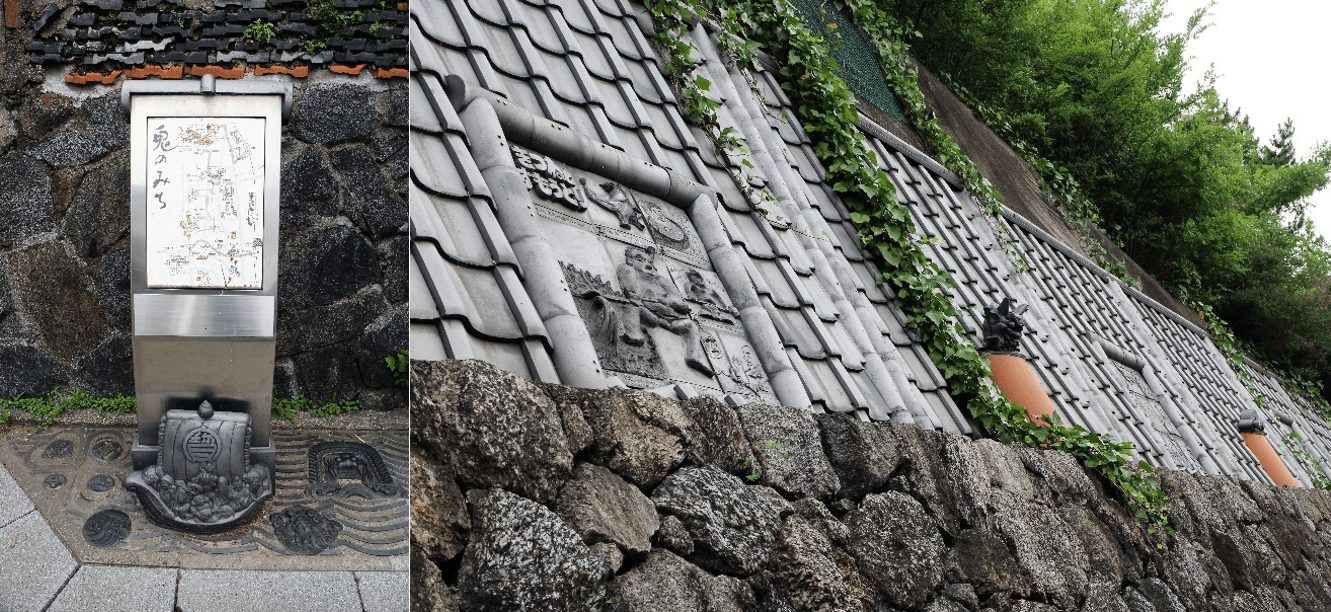 *鬼みち「新日本歩く道紀行100選ふるさとの道」「美しい日本の歩きたくなるみち500選」選定
*鬼みち「新日本歩く道紀行100選ふるさとの道」「美しい日本の歩きたくなるみち500選」選定
常設展示|3F常設展「たかはま・かわら・三州瓦」
続いて、主任学芸員 井上さんよりご案内いただいた3Fにある常設展示のメインスペース。
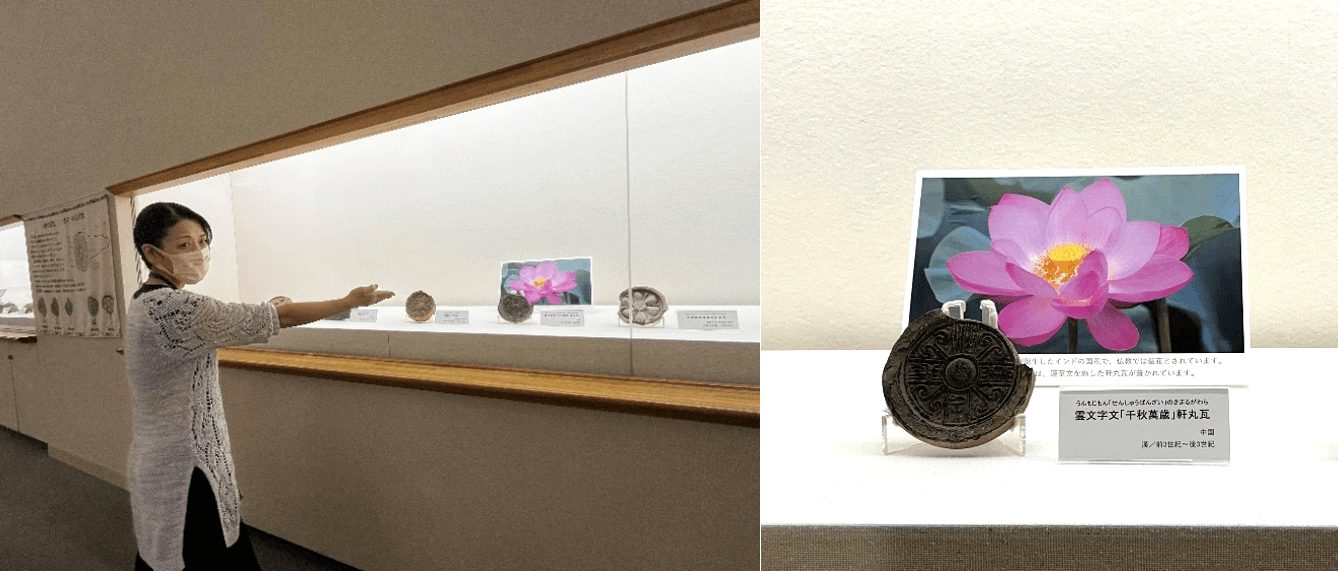
ここでは、三州瓦から国内外の貴重な瓦が時系列ごとに並べて展示されています。
紀元前11世紀頃、中国で生まれ、朝鮮半島を経て飛鳥時代に日本に伝わり、現代までつくられ、使われてきた瓦の歴史を、貴重な瓦コレクションとともに解説いただきました。
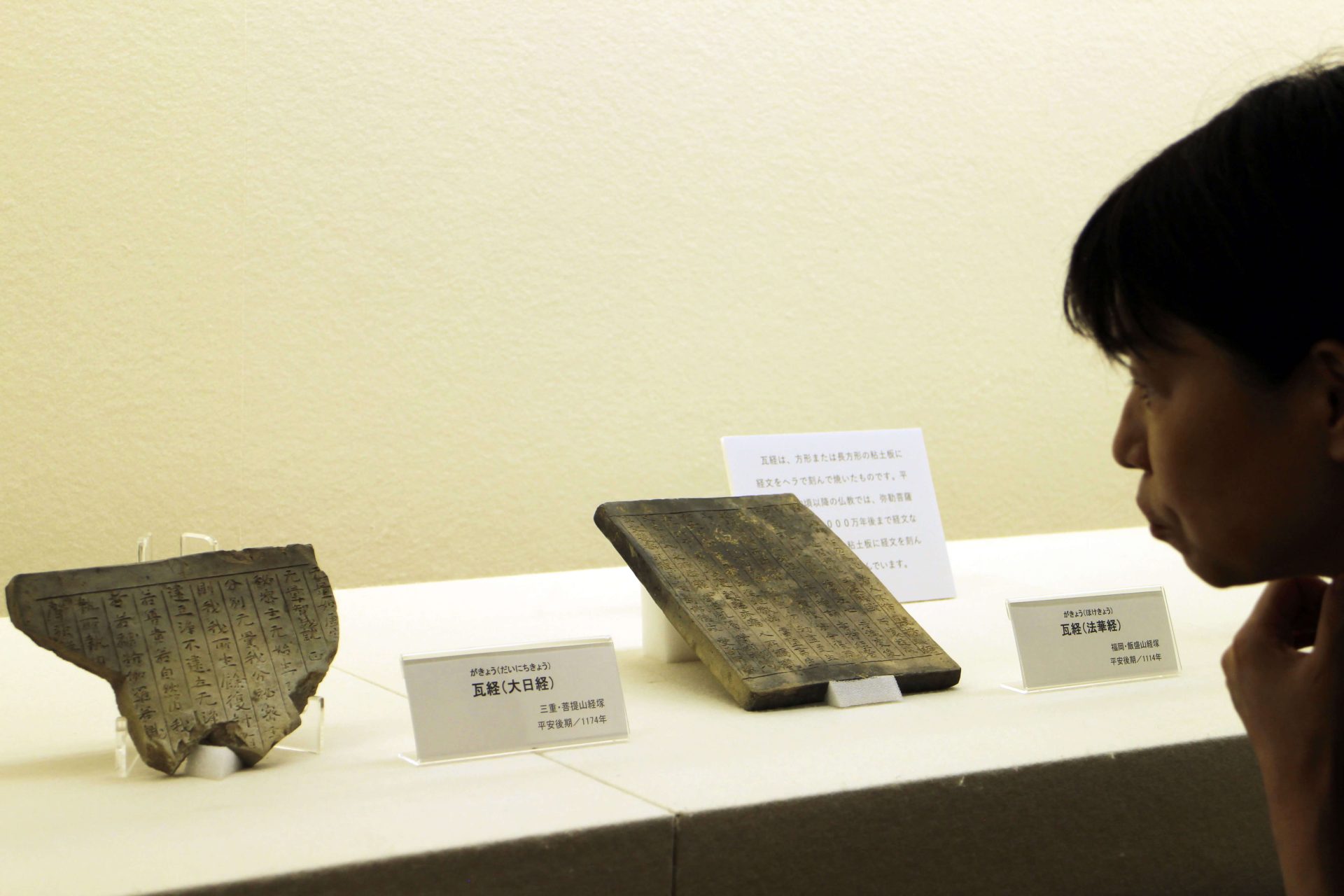
*瓦経(がきょう)|後世に経典を伝えるため瓦素材で焼かれた平安時代のやきもの。しっかり読める文字の鮮明さに驚く
2017年より「伝統工芸品」として認定された三州瓦は、職人技が必要な手作業でしかつくれない高級な鬼瓦で、高浜市は全国でも30~50名ほどの「鬼師」と言われる職人が一同に集まるまち。
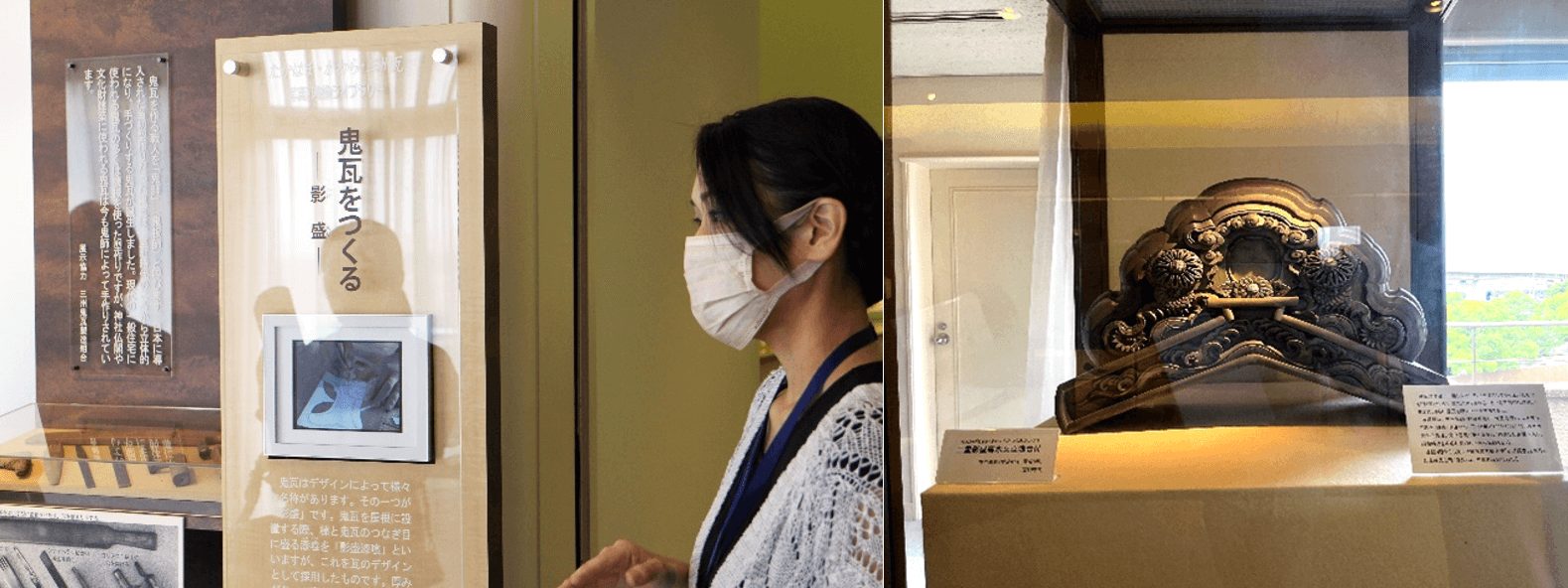
三州瓦の展示コーナーでは、鬼師の技が光る手づくりの造形的な瓦、昔ながらの瓦造りから、現代の最先端の瓦造り、そしてエコで経済的で安心・安全な瓦の秘密がのぞけます。
2F企画展|「ヤマザキマリの世界展 ―世界で生きて、世界を描く―」
図書館と企画展スペースがある2Fでは、取材中に開催していた企画展「ヤマザキマリの世界展 ―世界で生きて、世界を描くー」(6月末で終了)を担当された学芸員 竹下 和貴子さんにご案内いただきました。
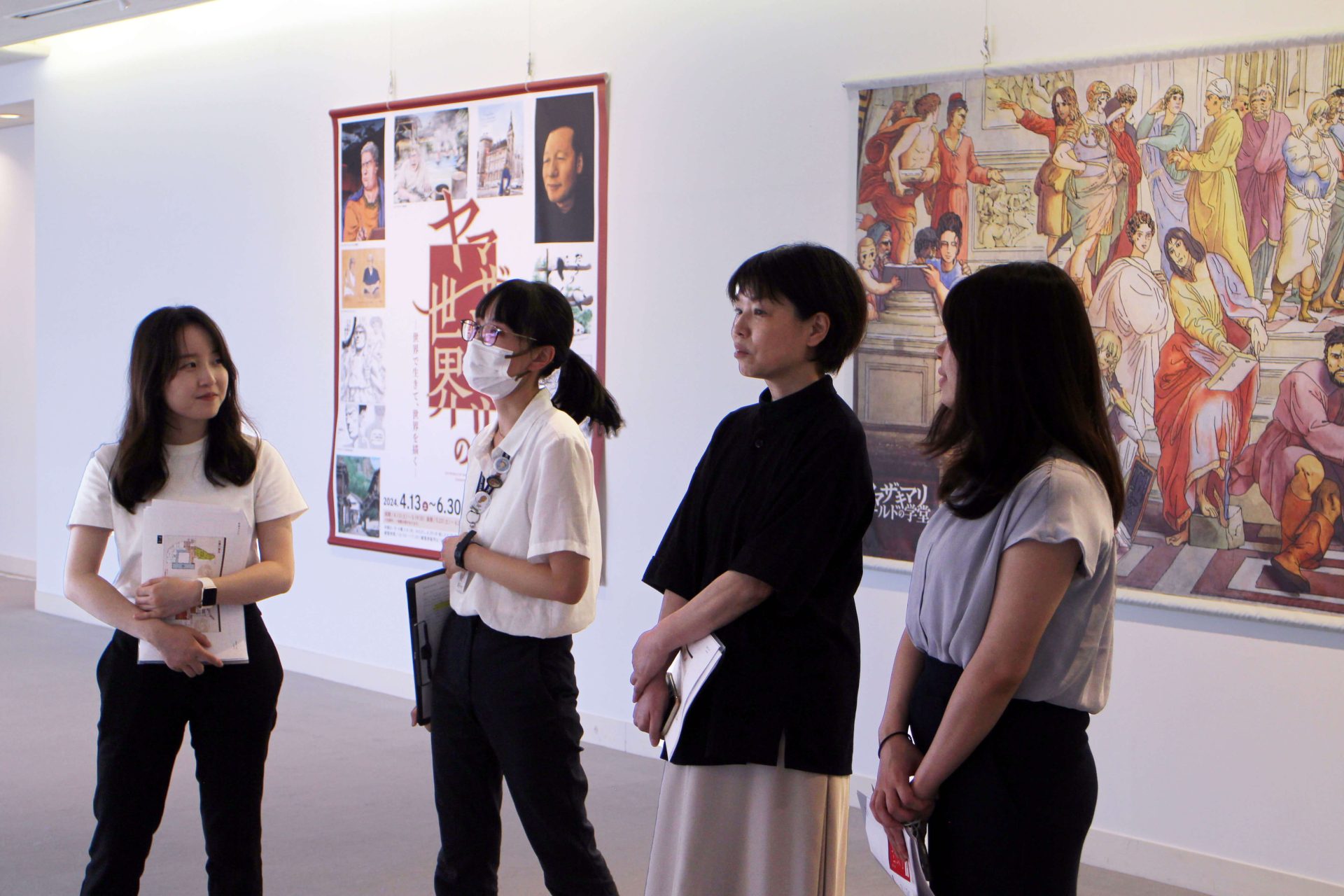
*学芸員 竹下 和貴子さん(写真左から二番目)
この企画展はヤマザキマリ氏が客員教授を務める東京造形大学など、竹下さんご自身のネットワークがあったからこそ実現できたもの。展示はもちろんのこと、竹下さんの作家や作品への溢れる愛、豊富な知識と楽しい解説にメンバー一同、展示の世界に引き込まれていきます。
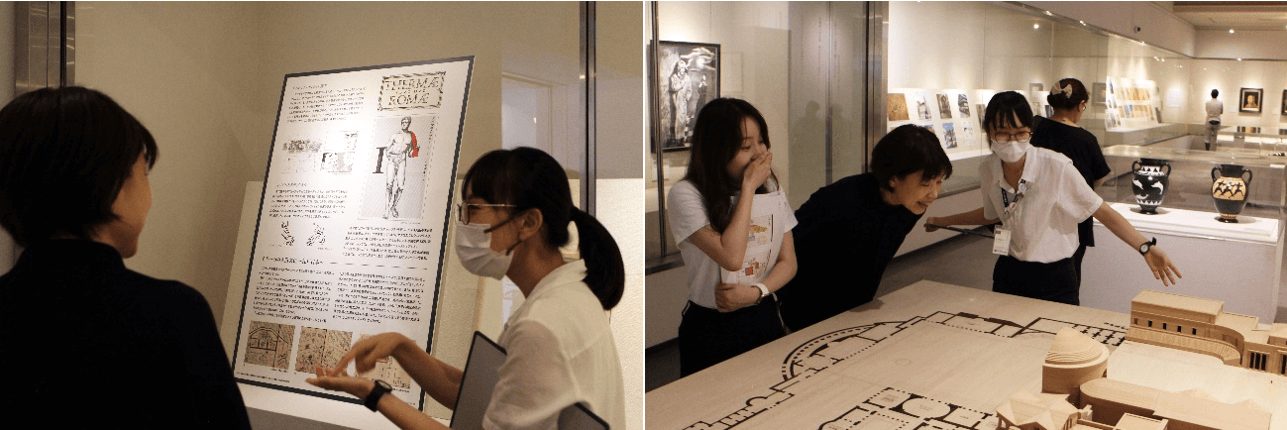 *カラカラ帝浴場 復元縮小模型(右)|製作:東京造形大学
*カラカラ帝浴場 復元縮小模型(右)|製作:東京造形大学
学芸員に聞く!「高浜」ならではの企画展を考える
2Fの企画展スペースでは、7月27日(土)より『絵本作家たかいよしかず展~ようかいむらと鬼のまち~』が開催されます。
この企画展を担当された、主任学芸員 井上 あゆこさんとイベントを担当する杉谷 紬さんに、施設運営事業チームが展示企画の経緯や想いを伺いました。
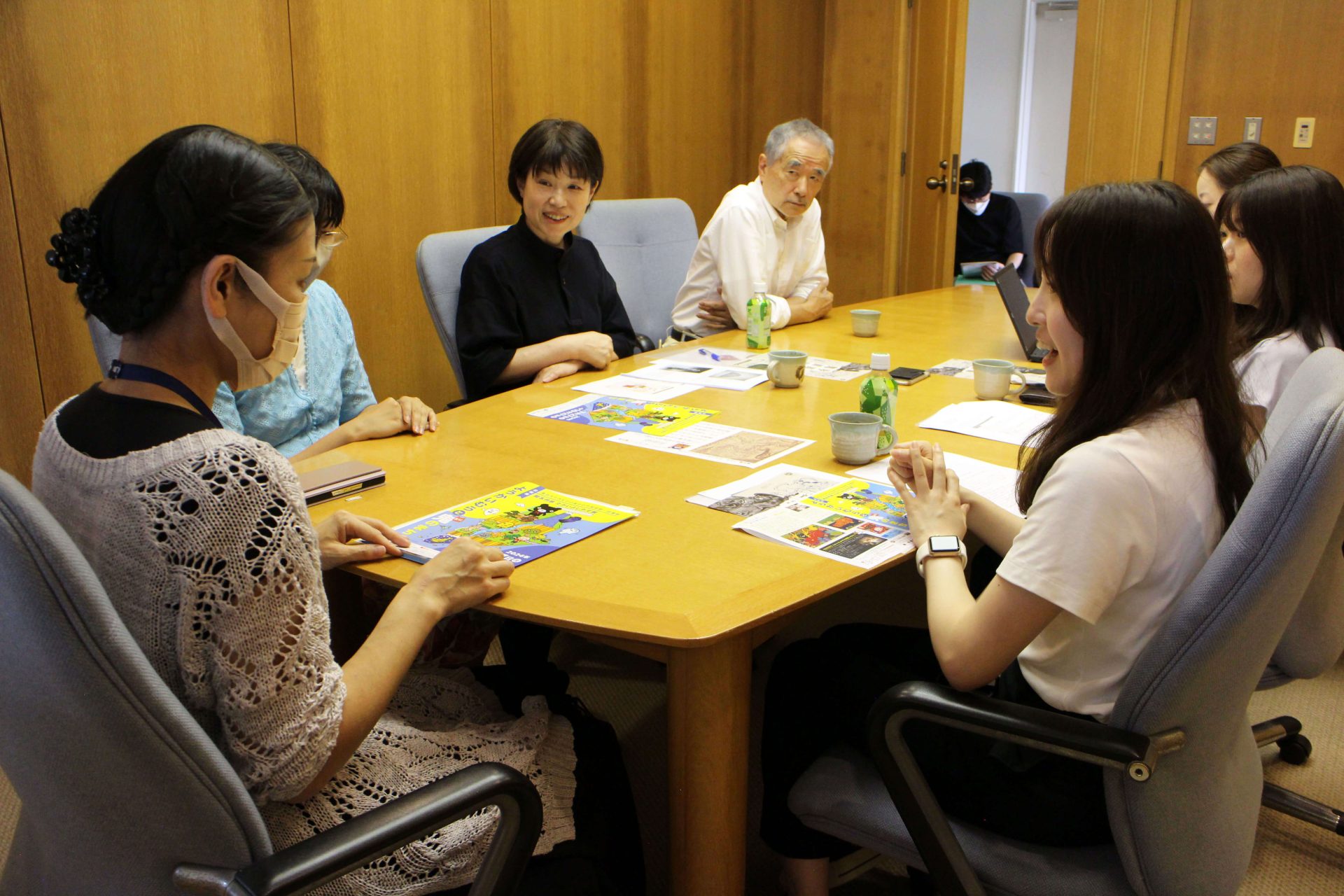
日野
今回実現した「たかいよしかず展」。展覧会を企画した経緯を伺えますか?
井上さん
今回は、夏休み期間の展示ということで、夏休みらしいもの、かわら美術館・図書館ならではの企画として、いくつか候補があった中から、たかいよしかず氏の企画を選びました。
たかい氏は、高浜市の食育キャラクター「カワラッキー」のデザインや、市民憲章記念事業で高浜市の絵本制作を手がけられ、高浜市ともゆかりのある作家さんです。
「鬼瓦」のように、ちょっと怖くて固い印象を与える瓦と高浜市のイメージが、可愛らしいキャラクターデザインと鮮やかな色彩によって、とても親しみやすい印象に変わったと思います。
【たかいよしかず氏(絵本作家、デザイナー)】
『ようかいむら』(国土社)シリーズや『おはなし・くろくま』シリーズ(くもん出版)の絵本のほか、『怪談レストラン』シリーズ(童心社)の装丁・挿絵、明治マーブルチョコレートの「マーブルわんちゃん」、牛丼チェーンすき家の「すっきー」など、多くのキャラクターデザインを手がける。ボローニャ国際絵本原画展では入選を果たすなど、絵本作家やイラストレーターとして活躍中。

高浜市こども食育マスコットキャラクター
かわら食人(しょくにん) カワラッキー(デザイン/たかいよしかず氏)
食べることが大好きな、たかはまの鬼瓦の精。料理の腕はプロ級。和食・洋食・中華・デザート。そのレパートリーはとどまるところを知らない。食べ物を大切に・すききらいをなくそうを モットーに日夜飛び回っている。
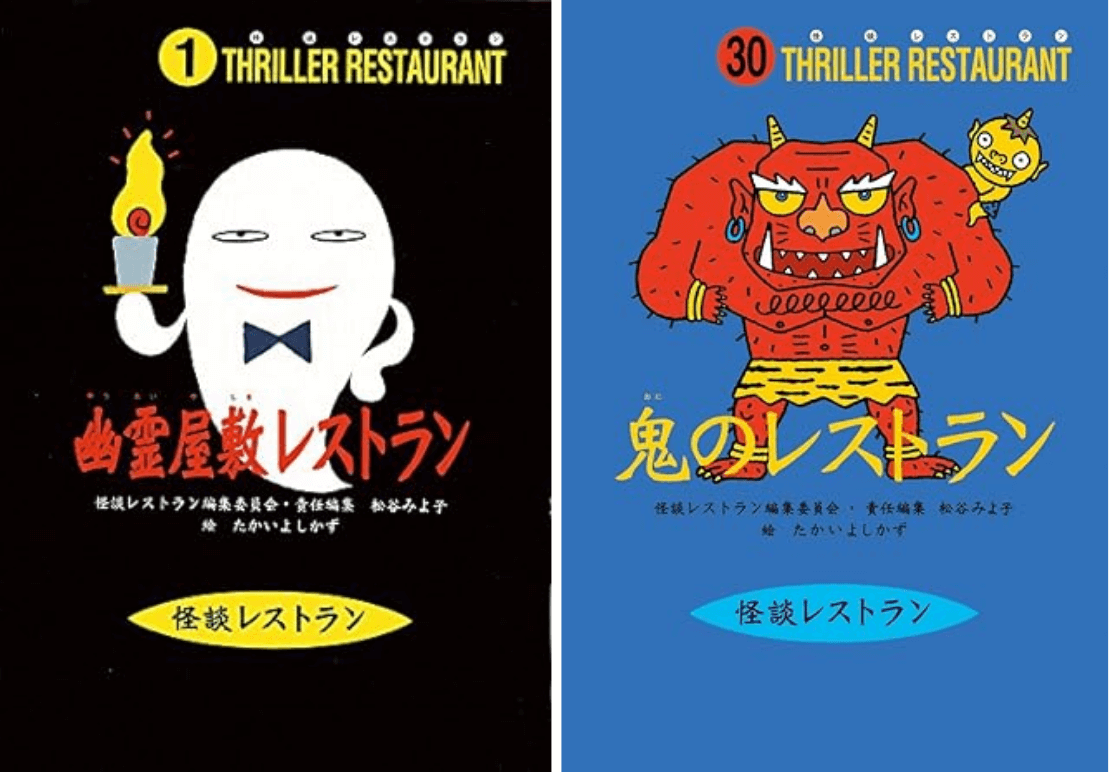
児童書『怪談レストラン』シリーズ / 絵・たかいよしかず
怪談レストラン編集委員会・責任編集 松谷みよ子
日野
かわら美術館・図書館は、美術館と図書館が複合された全国でもめずらしい施設ですが、企画をする上で何か連携を意識されたポイントはありますか?
井上さん
そうですね、図書館もあるので、企画展は図書館スペースとも連携した展示や書籍のセレクトを行ったりしています。
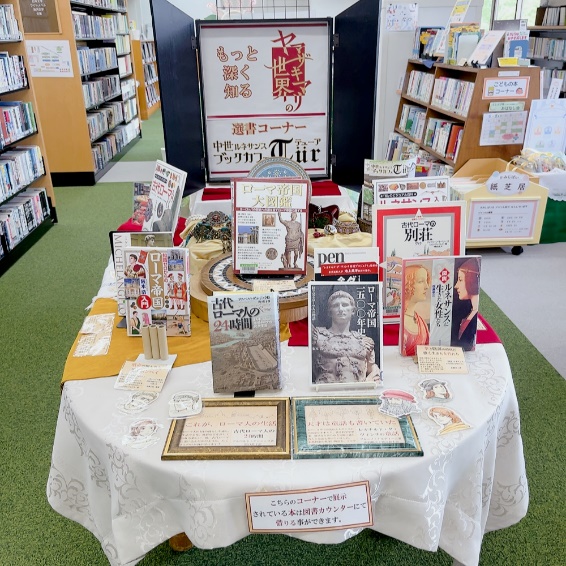
*ヤマザキマリの世界展 | 図書館には企画展と連携した選書コーナーが設置
今回の企画展では、絵本と絡めた展示を意識しました。たかいよしかず氏の絵本の中で、夏休みらしいものは何だろうと考えた時、『ようかいむら』シリーズの中に登場するようかいキャラクターと瓦の展示は結びつけやすいのではないかと考えました。
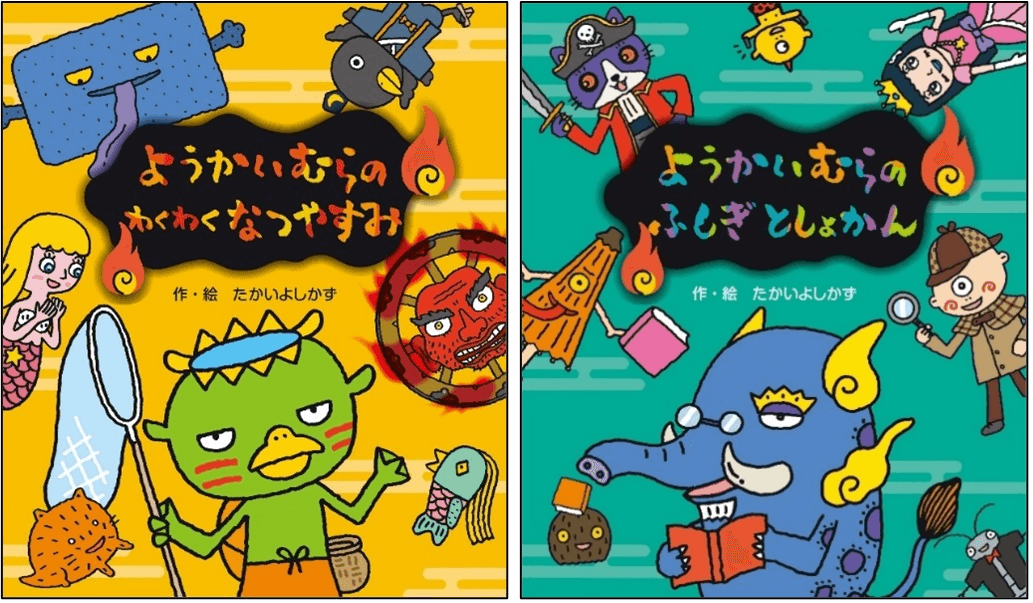 絵本『ようかいむら』シリーズ / 作・絵 たかいよしかず
絵本『ようかいむら』シリーズ / 作・絵 たかいよしかず
©️YOSHIKAZU・TAKAI / KYODA CREATION / KOKUDOSHA
個性豊かでかわいい妖怪たちが、仲良く暮らす村が舞台。お互いに尊重し共存するためのルールを学ぶ絵本。
夏らしい妖怪伝説 “かわら”とセットでより深く楽しめる展示へ
井上さん
当館には鬼瓦の様に鬼にまつわる瓦のほか、妖怪にまつわる建物の瓦もたくさんあります。
たとえば、「姫路城の瓦」。姫路城にも妖怪が住んでいるんですよ。
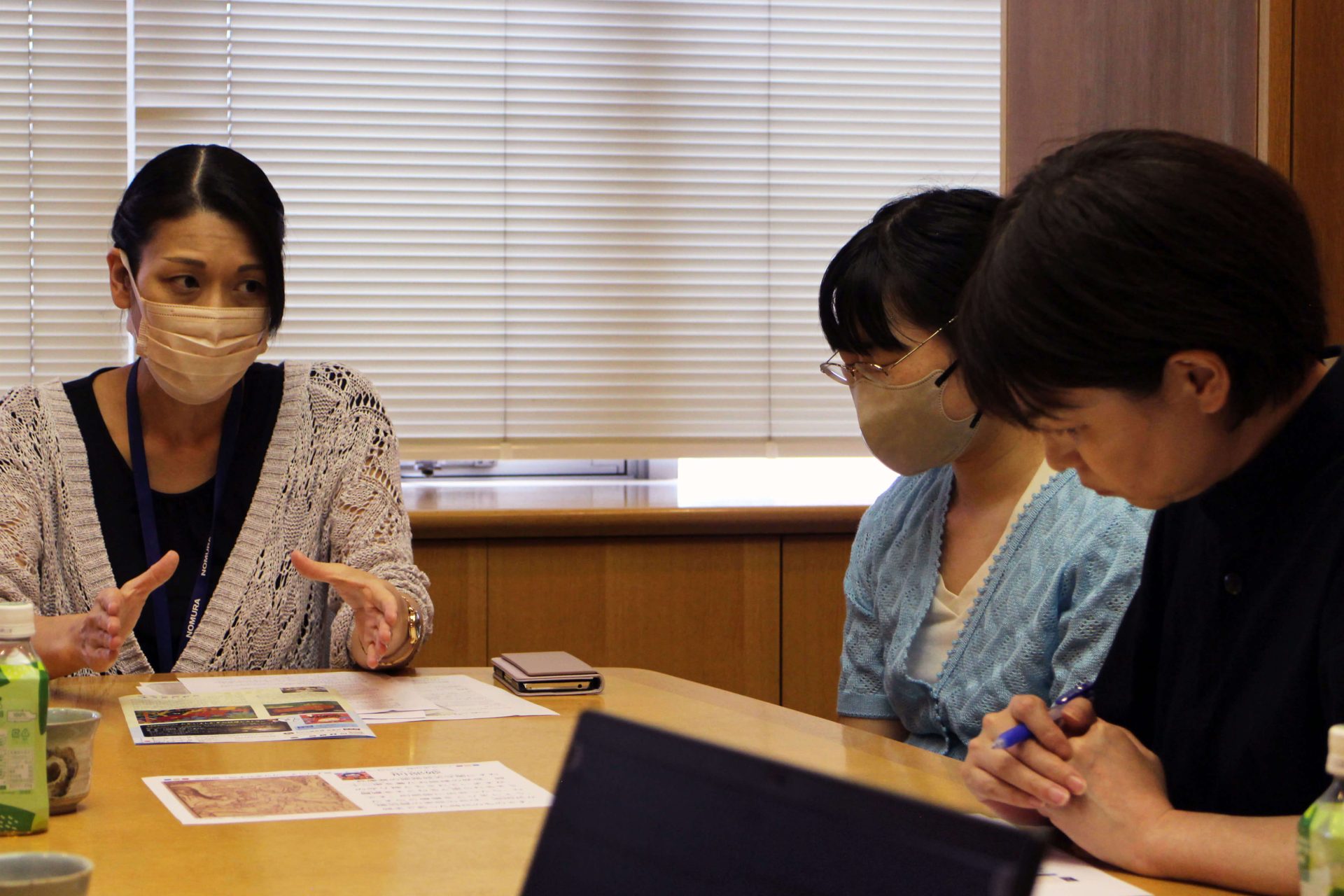
森
え、お菊さんではないのですか?
井上さん
姫路城の天守閣に住む刑部姫(おさかべひめ)です。割と有名な妖怪でして、たかいよしかず氏の絵本『ようかいむら』シリーズの中にも登場するキャラクターです。刑部姫に会って気に入られると、その城主が治める時代は繁栄するといわれています。
江戸時代の妖怪伝説なのですが、刑部姫の噂を知る若い小姓が、ある晩、仲間にそそのかされ肝試しに天守閣に登ったら、そこには十二単で本を読みふけっている姫がいたと。
「お前は誰だ!」と言われた小姓は、名を明かし正直に伝えると、それは勇気のあることだと、仲間に見せる証拠が必要だろうと姫が自ら、自分が身に着けていた兜のシコロ(首回りの部分)をくれたそうです。(諸説あり)
嘘をつかず正直に伝えた小姓は気に入られましたが、万が一、機嫌を損ねると呪い殺されるらしいといわれる女性の妖怪です。
こんな感じで、ちょっとゾクッとするような、夏休みっぽいものがいいかなと思いまして。
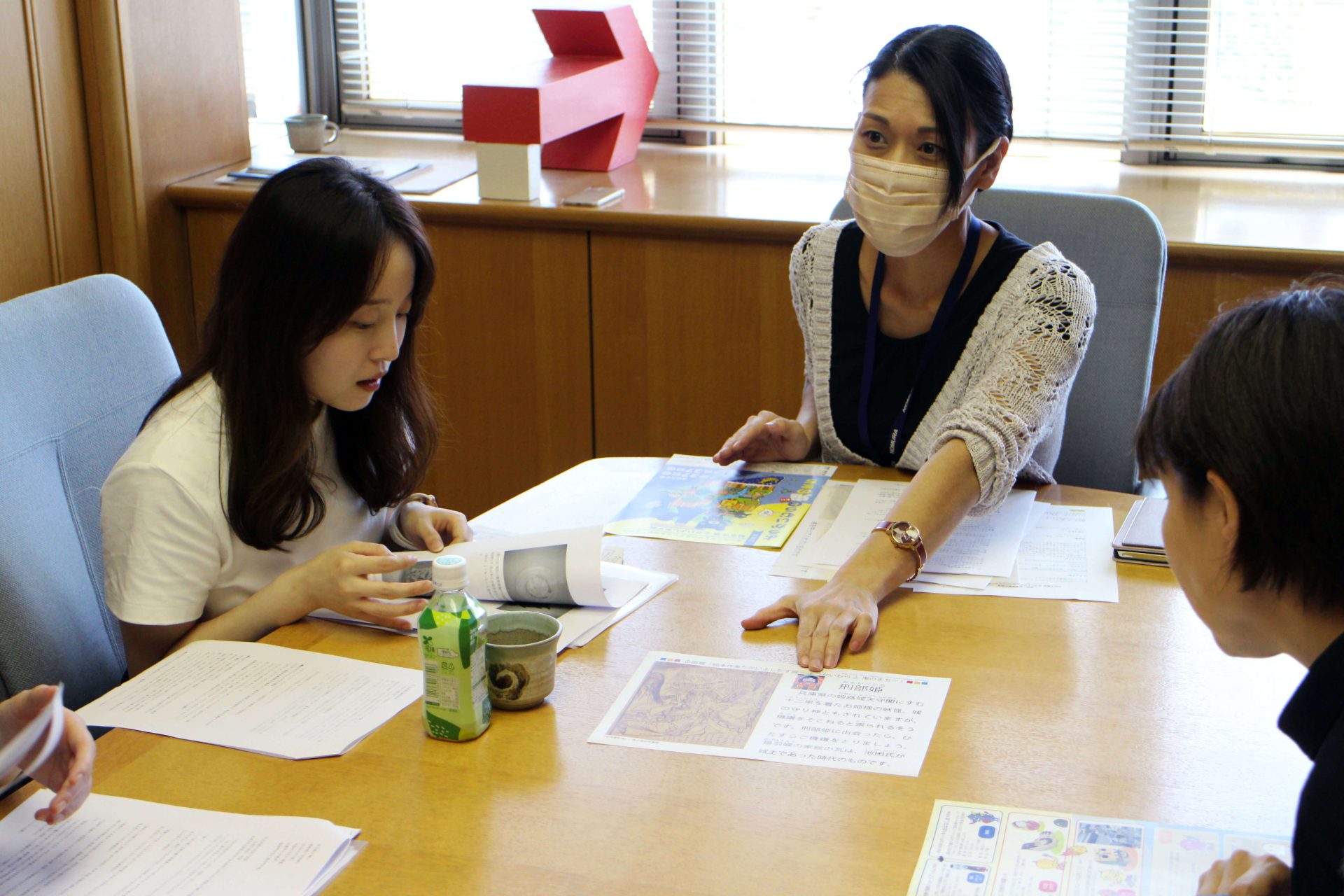
森
確かに、夏休みの時期はこういう怪談とか肝試しのような企画展は人気ですよね。
井上さん
ようかいむらシリーズには、たかいよしかず氏オリジナルの“ようかい”もいるのですが、ほとんどが江戸時代や平安時代からの文献にきちんと載っている歴史ある妖怪がそのままキャラクターになっています。
ようかいむらシリーズの親しみやすいキャラクターと、ルーツになっている文献と瓦をセットで展示する。今まさにそのキャプションを制作しています。
● 妖怪と関わりのある歴史的建造物の瓦+文書資料+『ようかいむら』キャラクター展示
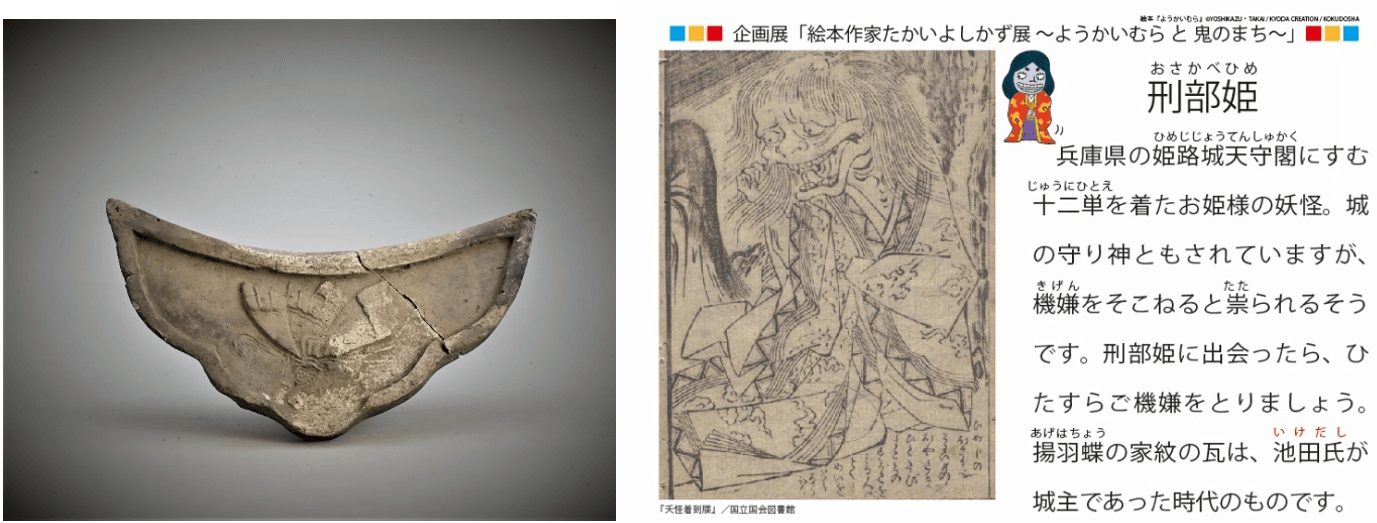 *「揚羽蝶紋軒平瓦」兵庫・姫路城(推) 16世紀-17世紀 安土・桃山-江戸時代
*「揚羽蝶紋軒平瓦」兵庫・姫路城(推) 16世紀-17世紀 安土・桃山-江戸時代
姫路城は、江戸時代だけでも30人以上の城主が入れ替わるため、城主の家紋を入れた姫路城の軒丸瓦には、多くの種類がみられる。揚羽蝶の家紋は池田氏のもの
青木
こういうキャプションは、いつもどのくらいつくられるのですか?
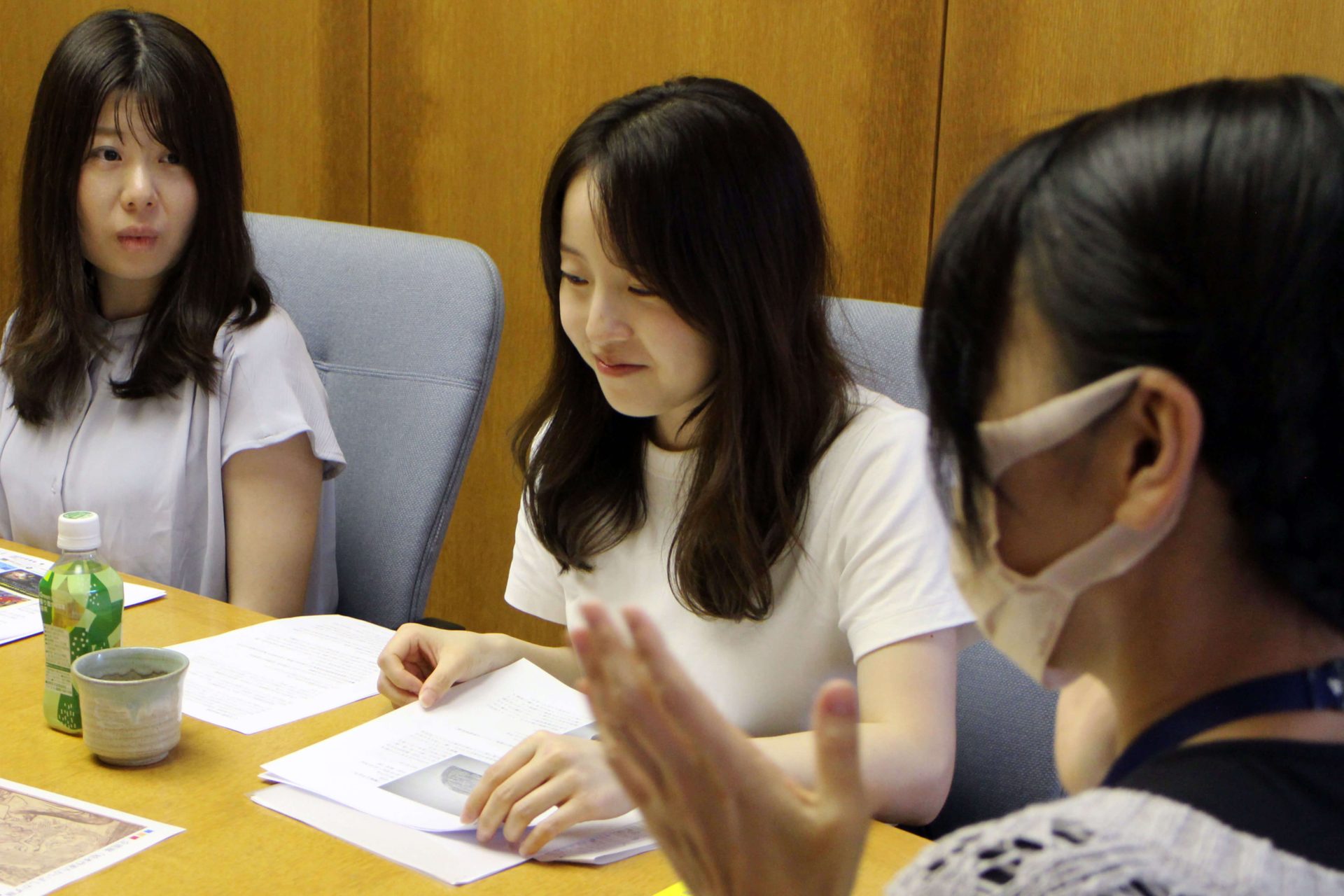
井上さん
今回のたかいよしかず氏のキャラクターと文献をあわせるだけなら20、30とつくれるのですが、保有する瓦とセットでとなると10前後くらいになりますかね。今、まさに展示に向けて使用可能な文献や画像を調べているところです・・・
個人所有の文献などは使えなかったりするので、一つ一つ調べながらやっています。
こどもだけじゃない!大人も楽しめる展示・イベント企画とは?
日野
開催期間は夏休みですが、子供向けに意識されているポイントや教育的要素などはありますか?
井上さん
普段からですが、今回も夏休みだからあえて子供向けに、とは特別に意識はしていないです。子供も大人もフラットにみんなが楽しんでいただけることと、帰ってからも心に残るような展示やキャプションづくりを心掛けています。
こうした瓦にもなっている鬼や妖怪は、背景のストーリーを紐解くと実は「教訓」につながっていくんですよね。「刑部姫」は女性の妖怪ですが、お城の天守閣に住み、城主ですら頭が上がらない女性って…
身近な現代に置き換えて考えると「奥様」ってことですよね。おうちにいて男性が頭が上がらない女性、奥様を大切にしないと家がうまくまわらないよ、という教訓が背景にみえてきます。
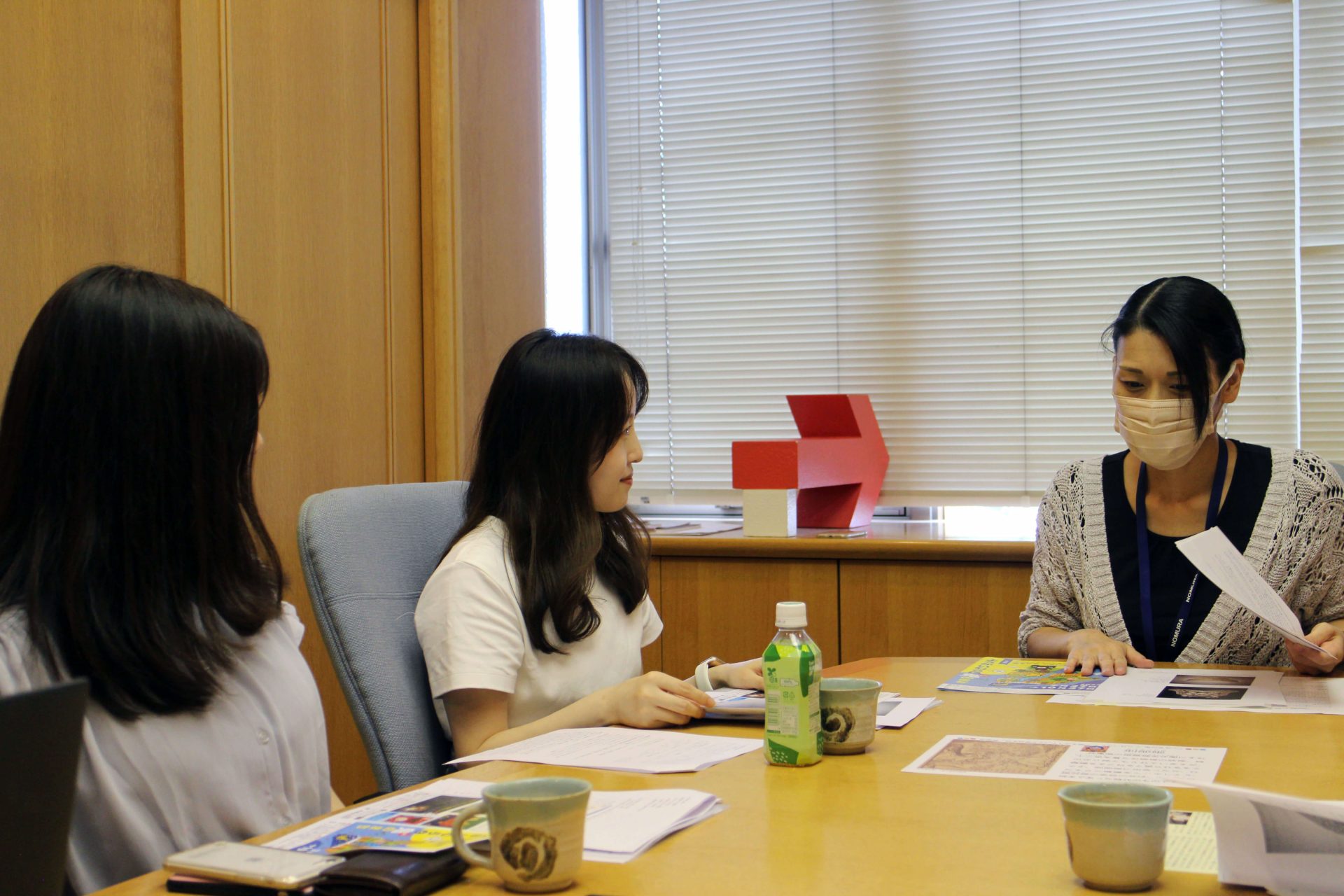
河童なんかもそうですよね、子供が一人で川に入らないようにとつくられた妖怪です。たかいよしかず氏の描く原画から、ようかいキャラクターの親しみやすさだけでなく、原画の中にのぞく背景のストーリー(教訓)も一緒に、より深く考えながら楽しんでいただきたいと思っています。
日野
妖怪だけど親しみやすくかわいらしい、たかいよしかず氏の作品と共に、地域の産業や学びにつなげていく。押しつけがましくなく、なんだか自然に教訓を覚えてしまう。そんな風に、ゆるやかに教育普及の要素にもつながっている感じがいいですね。
青木
杉谷さんは、企画展に関連するイベントやワークショップを企画されているのですよね?
今回のイベントやワークショップはかなり種類が多いと思うのですが、こちらは杉谷さんおひとりで担当されていらっしゃるのですか?
杉谷さん
井上さんが担当しているものと、私が担当しているもの、合わせてこれだけの数になりました。(本企画展の関連イベントは全12種)今回は夏休みの企画で、期間も長いので私も普段よりイベント数は多く設定しています。
井上さんから企画展のテーマや主旨を聞きながら、企画展のチラシ発行のだいたい3~5か月前にイベント企画を検討していきます。
森
このイベント「ヒヤッと!れいかん石けん」って、おもしろいですね!
イベント企画はネーミングもすべて杉谷さんが考えられているのですか?
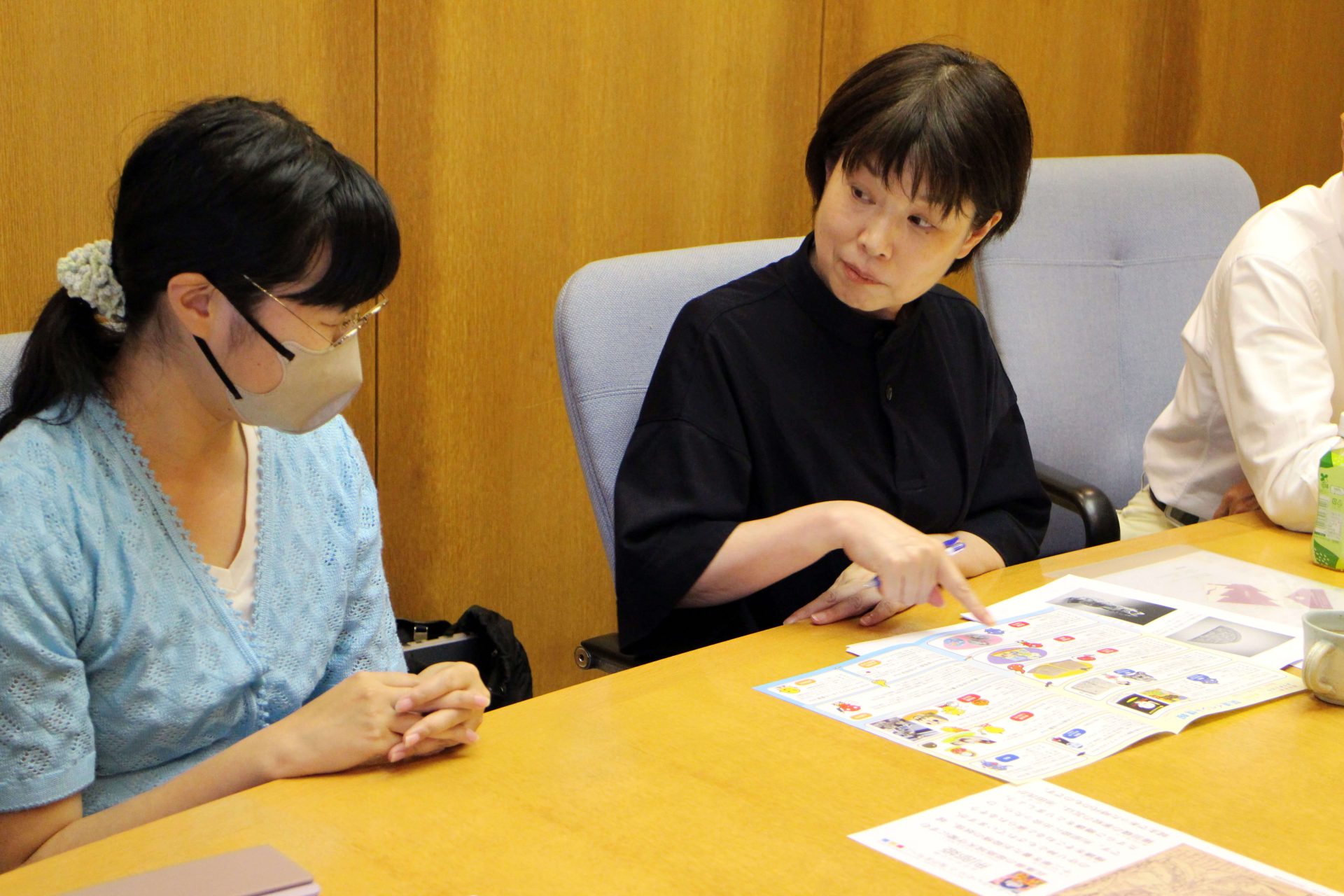
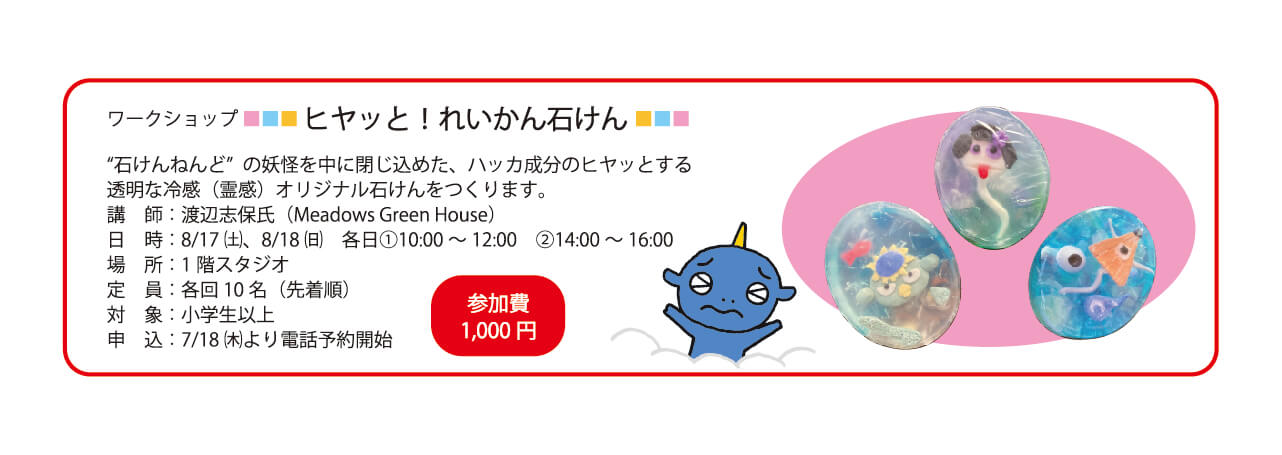
*「ヒヤッと!れいかん石けん」は満席となりました。
杉谷さん
私が担当するものはそうです。いくつも並んで出る情報ですから、なるべく同じ人がまとめるほうが見る方がわかりやすいですし、それぞれのイベントのテーマや役割なんかも際立たせることができると思っています。
森
普段、どのようなことを意識してイベントを企画されているのですか?
杉谷さん
やきものの里である高浜市にちなみ、陶芸体験の機会をなるべく作るようにしています。
図書館と一緒になったことで、2Fで開催されていた陶芸教室がなくなってしまったので。特に高浜市の鬼師さんによる企画展に合わせた“かわらをつくる体験イベント”はいつも大切にしています。
森
焼き物イベントは、高浜の鬼師さんに直接お願いするのですか?
杉谷さん
はい、鬼師さんには普段の付き合いのなかで、お願いしていくことが多いですかね。しかし、様々なイベントを幅広く展開していく上では、知り合いでない方にもどんどん声をかけていく必要があります。今回の石鹸イベントはインターネットで探したり、ようかいパレードはSNSでDMを送ったり……
日々、情報収集しながら企画を進めています。
井上さん
鬼師さんとは、ミュージアムショップで瓦や企画展にちなんだグッズを製作・販売しているので、普段からお付き合いはありますね。あと、まちを歩いていたら普段からよく鬼師さんに会うんですよね。
森
高浜ならではの光景なのでしょうか?(笑)以前は、そこまでこの館と鬼師さんのお付き合いが深くはなかったように思うのですが、若松統括や井上さん、杉谷さんをはじめ皆さんが日ごろから地域や鬼師さんとのコミュニケーションを大事にされているからこそ、地域の“らしさ”を大切にした親しみやすい美術館・図書館になっていくのでしょうね。
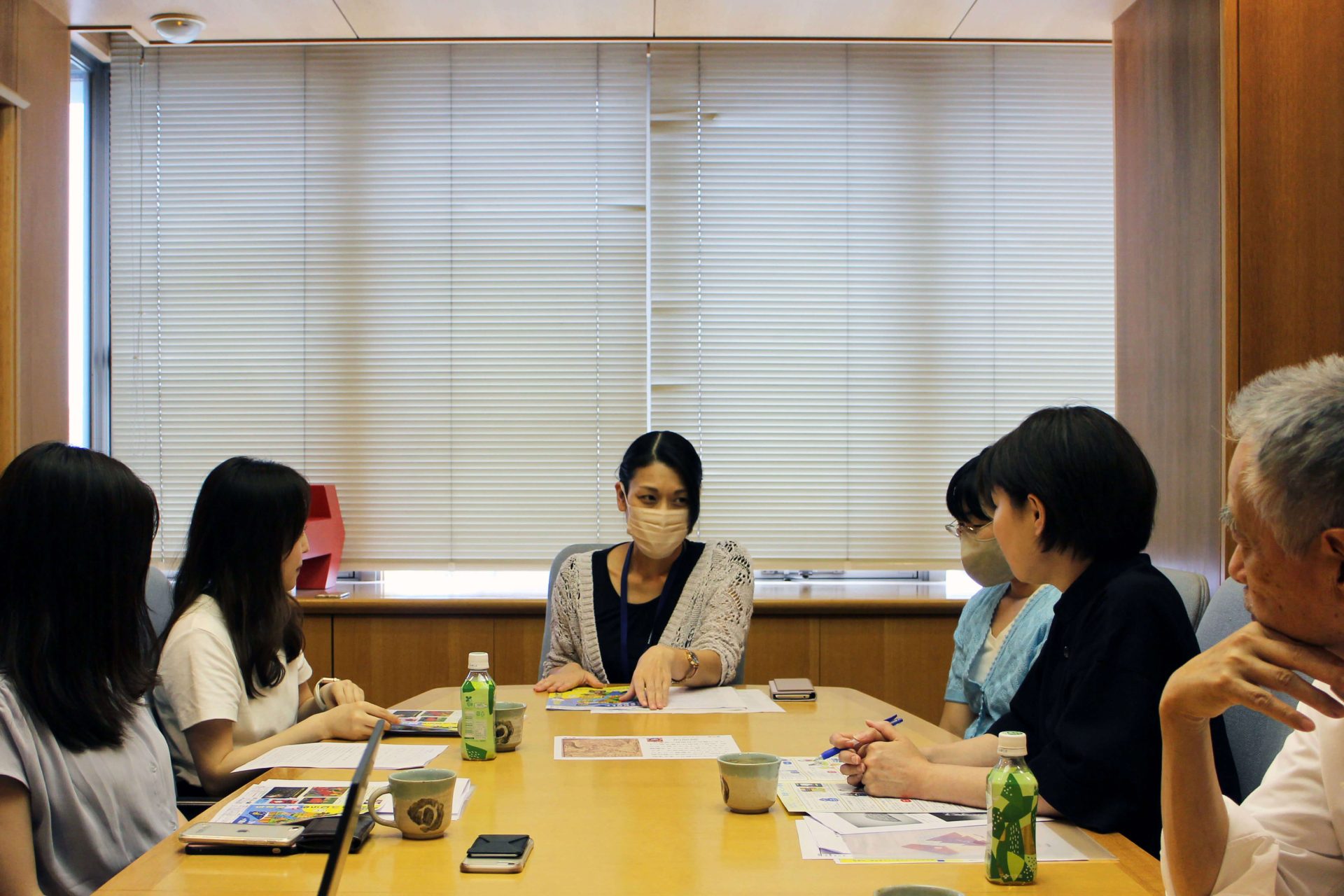
地域とひとをつなぐ「みんなで美術館」
森
これまでどんな企画展を行ってこられましたか?「高浜市」や「かわら」に直接関連する企画展から、写真展やアニメーションなど幅広いジャンルのおもしろい企画展が多いですよね。
井上さん
館名に「やきものの里」とか「かわら」という単語が入っていますので、三州瓦生産の中心である高浜市らしい企画は心がけています。小規模な施設ですが、当館でしかできないテーマを考え、広報・事業・ショップなどそれぞれの担当者がコンセプトを決めて展開しています。
日野
鬼師さんの持ち込み企画なんていうのもあったりするのでしょうか?
井上さん
そうですね、鬼瓦の企画展をやってほしいと言われたりします。
市制50周年、開館25周年記念の企画展「手鏡帖と鬼師展」なんかもそうですね。当館所蔵の江戸時代の図案(手鏡帖)を見せて、鬼師さん一人ひとりに新しく企画展用の作品を作ってもらいました。
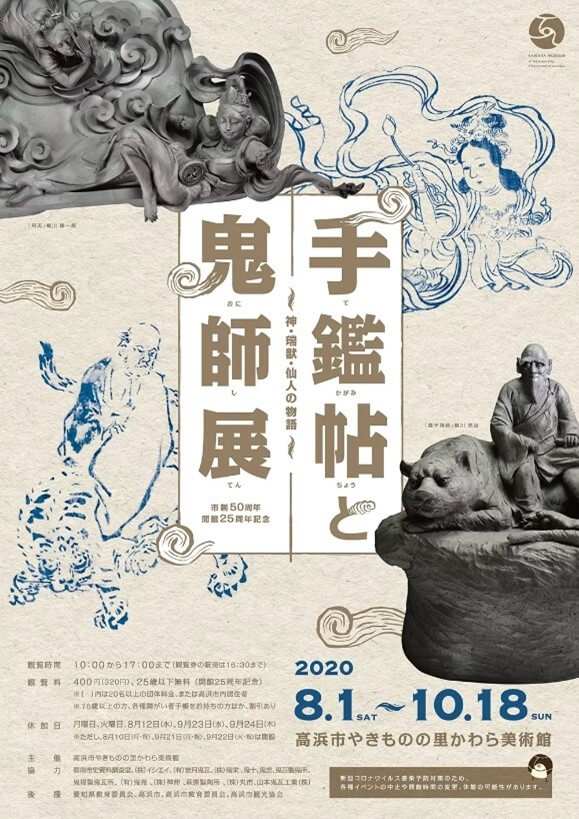
*市制50周年・開館25周年記念 手鑑帖と鬼師展 ~神・瑞獣・仙人の物語~(2020年開催 現在は終了)
森
美術館から作品のテーマをお願いできるなんて、日ごろからの鬼師さんとの関係性が深まっていないと、なかなか実現できないことですよね。
井上さん
そもそも建材である瓦を美術品・伝統工芸品として価値を高めていくこと自体、高浜にある地域の美術館としての大切な役割だと考えています。特に、瓦生産の中でも高浜の「鬼師」になるには鬼瓦専門の特別な職人技術が不可欠です。美術館で作品を展示することで、鬼師さん自身やその作品価値の向上にもつながっていきます。
森
今回、おふたりにお話しを伺ってみて、それぞれの力を掛け合わせて相乗効果を高めていくようなスタイルだと感じました。一人ひとりの力が倍以上になり、企画展の魅力を高め、それが館の魅力につながっていますよね。
また、鬼師さんや地域との関係性も、館が保有する歴史的な収蔵瓦だけでなく、新たな作品も一緒につくり上げて展示する、まさに、ここならではの“らしさ”を活かした地域へ還元する企画づくりを意識されている。
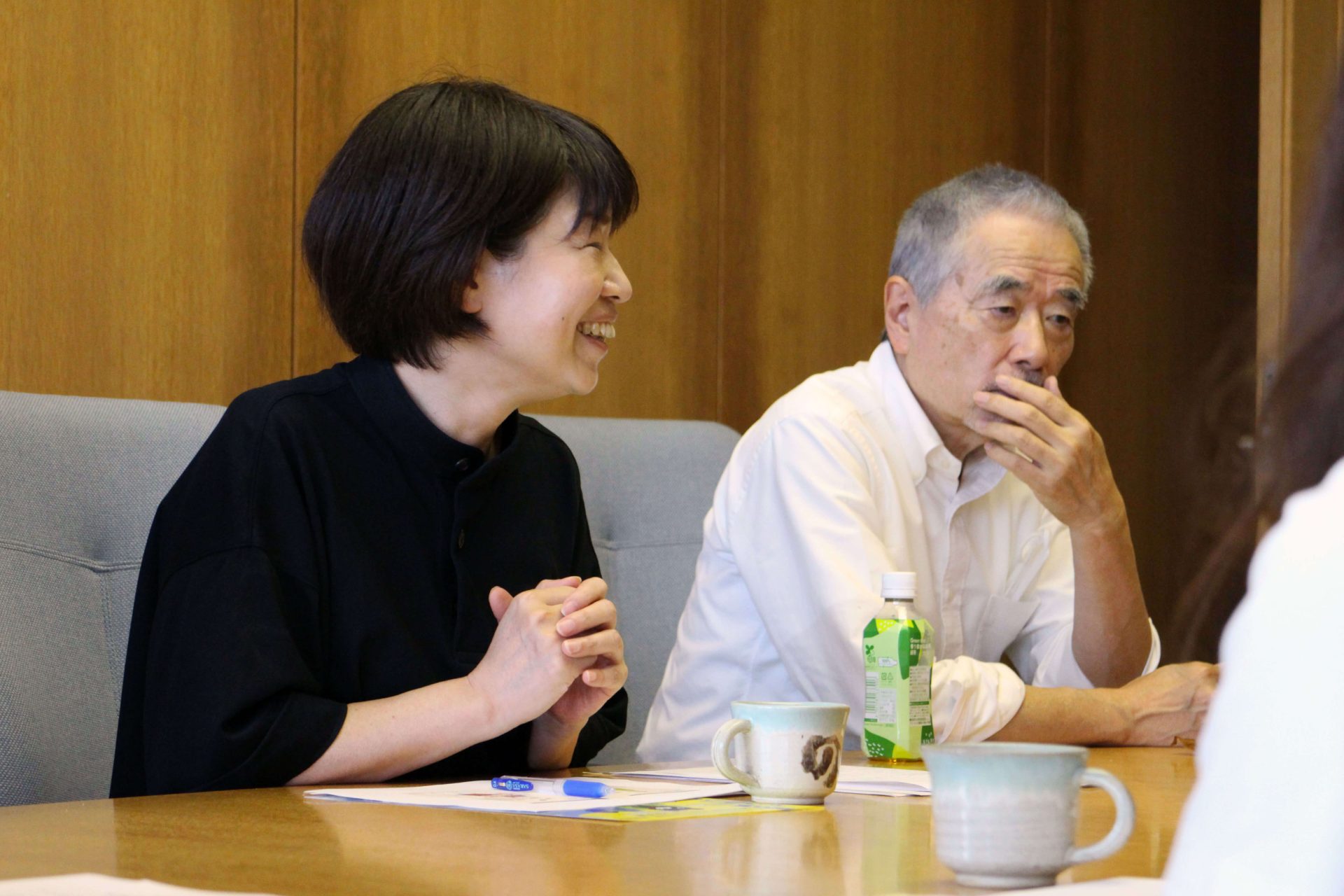
井上さん
職員が若松統括を含め7人なので会議を開催するまでもなく、常々コミュニケーションをとっているからできることですかね。テーマさえ決まれば、あとは一人ひとりが独自に考えて進めていくことができるチームです。
森
愛知は、競合となるような美術館が多いエリアですよね。そんな中、高浜まで足を運び見に来ていただける展示を少人数のチームでどうやってつくっているのですか?
井上さん
展示会のパッケージはある程度決まっているので、他施設と差別化するには、瓦とどうリンクさせていくか、そこは常に意識しています。企画展の自由度は他施設よりは高いかもしれませんが、常に年に一回はかならず瓦を打ち出す企画展を心掛けています。
若松統括
縁もゆかりもない企画展は普通の公共の美術館では開催しにくい空気感があります。でも、当館では自由度の高い企画も実現していっています。当館の学芸員は企画をゼロから作り上げることも、独自のネットワークや企画力で面白い展示を引っ張ってくることも、巡回展の内容を瓦や館蔵品に絡めて独自に編集していくこともできます。井上さんをはじめ、うちの学芸員やスタッフ一人ひとりの能力が当館を支えています。少数精鋭でこれだけのことができているのは、優秀なメンバーが集まったからで、本当にラッキーだなと思いますよ。
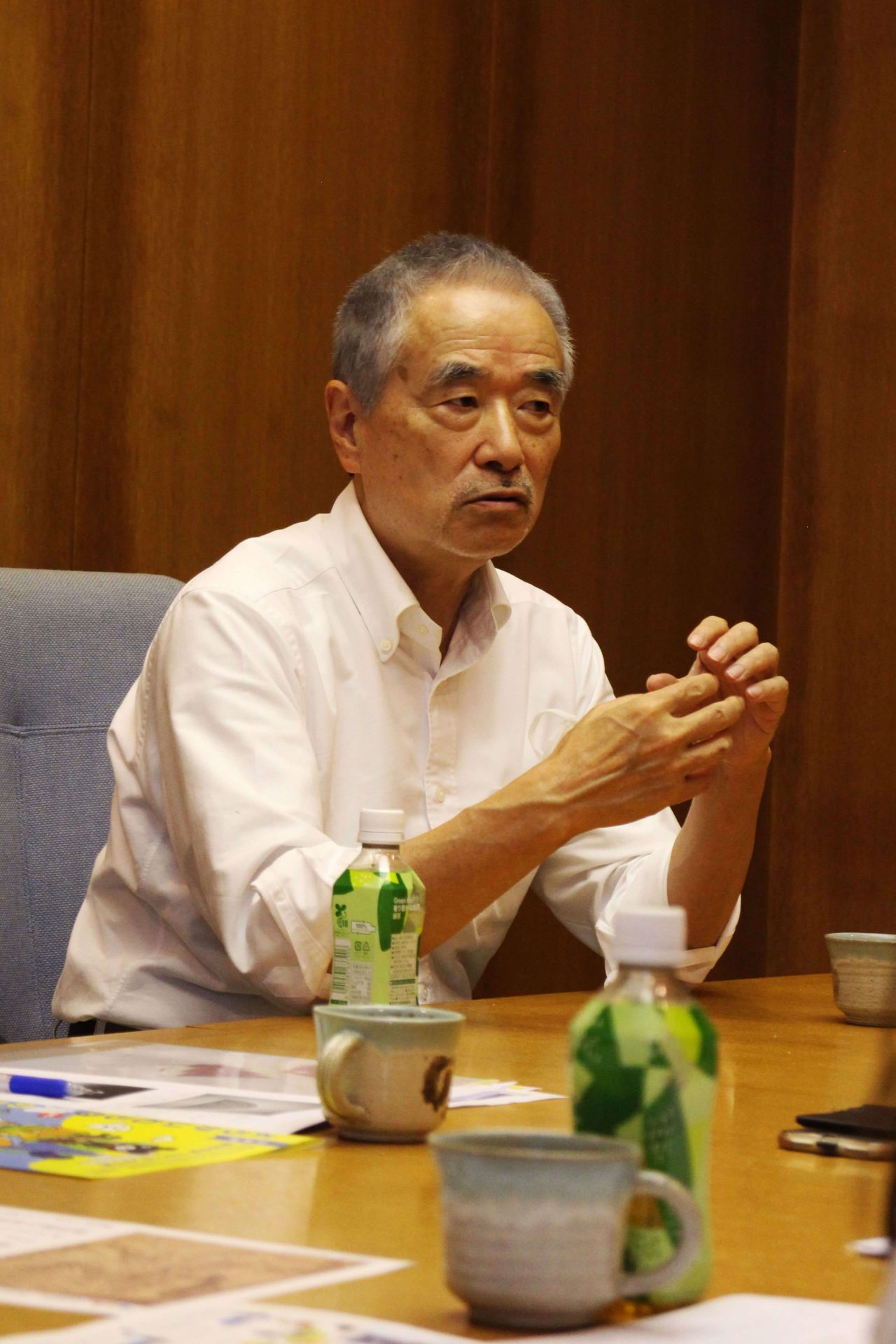
森
確かに、皆さん学芸員の仕事の枠組みにとらわれず、プロジェクトマネジメントも当たり前に行っていますよね?
今回のように、小規模な館の限られた予算の中で、発想を広げて館の鬼瓦とたかいよしかず氏の「ようかいむら」を組み合わせたり、外部ネットワークで「ヤマザキマリの世界展」を実現させているのは、「小さくても面白いことをやろう」という熱意と企画力、地元愛の賜物ですね。
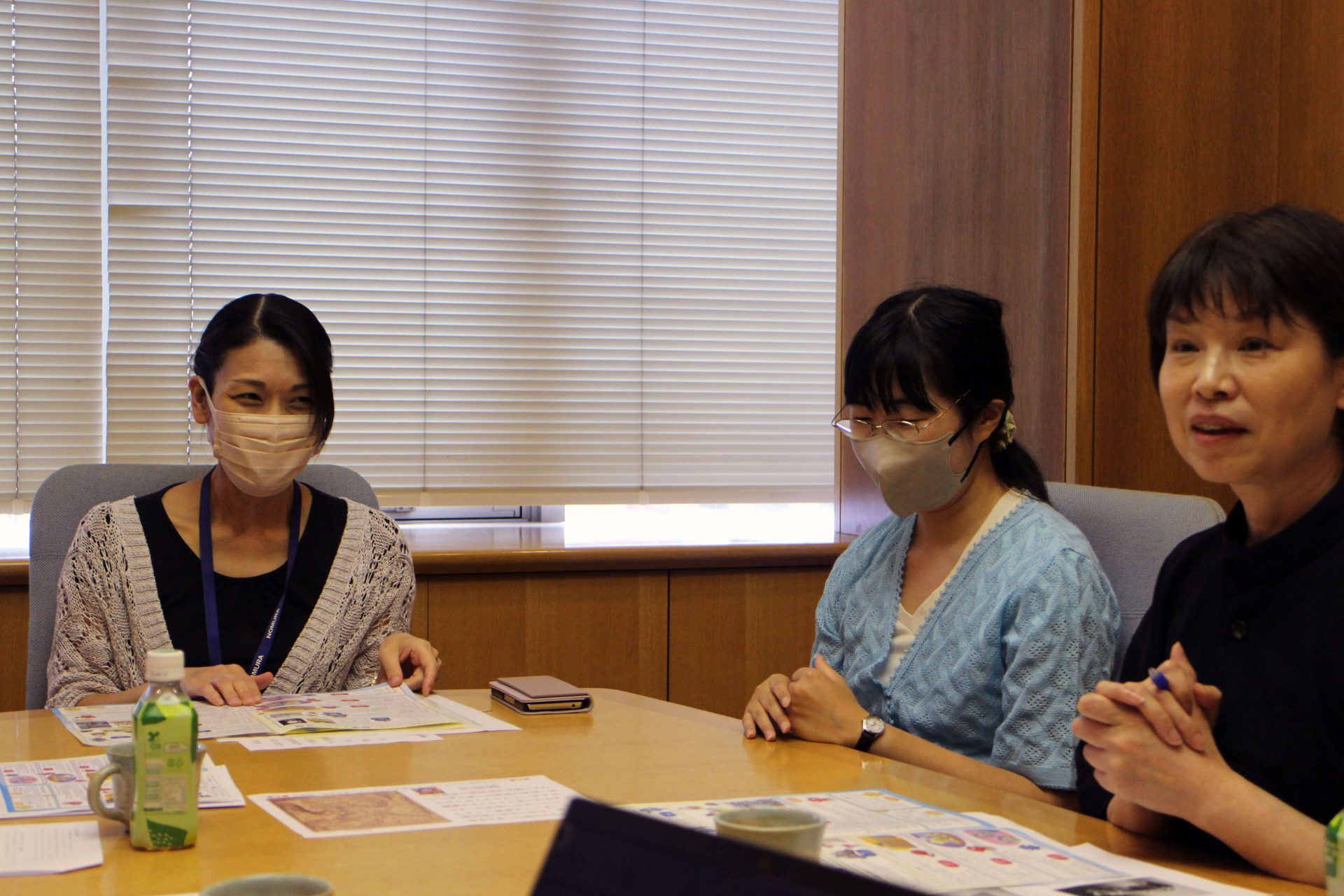
学芸員がおすすめ!「たかいよしかず展」の楽しみ方
青木
最後に、おふたりがおすすめする「たかいよしかず展」の楽しみ方があれば伺えますか?
杉谷さん
夏休み期間で通常よりも長い開催期間の企画展です。関連イベントも普段よりたくさん開催されますので、ぜひ展示とセットで多くの方にご参加いただけると嬉しいです。
井上さん
そうですね、展示もイベントも子供だけでなく大人も楽しめるように工夫しています。ぜひ家族全員で展示をみて、ワークショップに参加して、レストランでコラボランチなんてコースはいかがでしょうか。
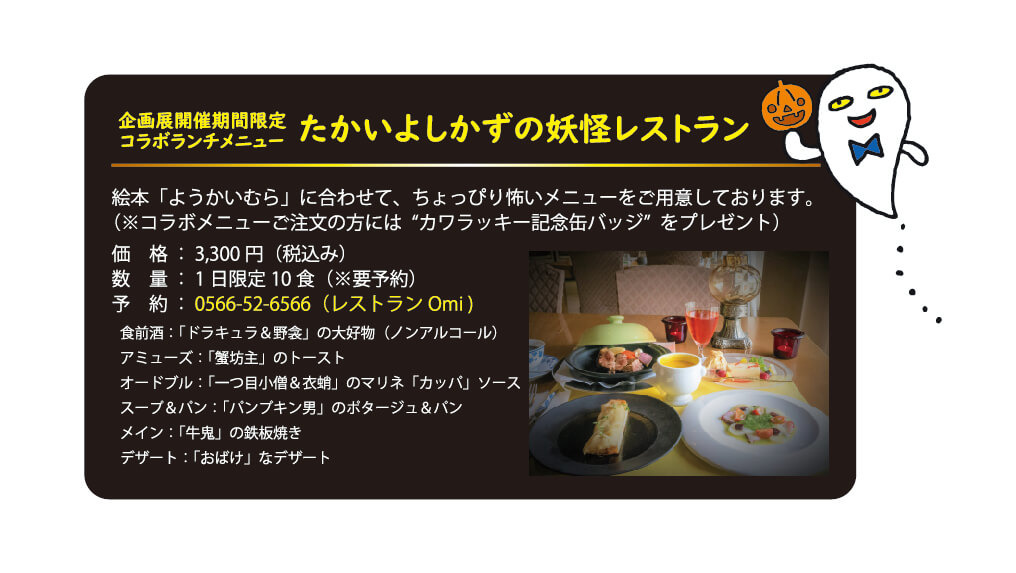
森
まさに誰もが楽しめる「みんなで美術館」として、一日中楽しめる公園のように過ごしていただきたいですね。
●展覧会概要
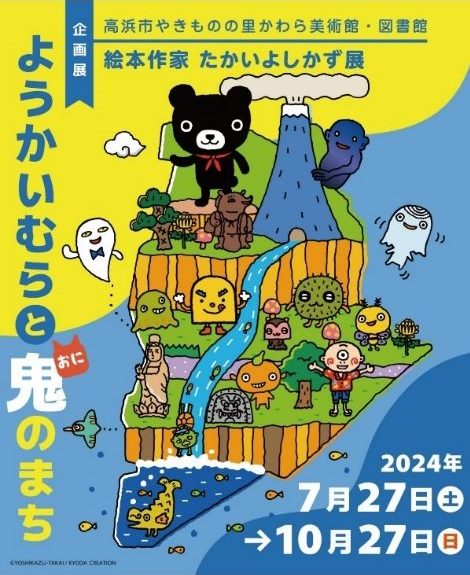
開催期間:2024年7月27日(土) 〜 10月27日(日) 10:00~17:00(観覧券の販売は16:30まで)
*月曜日、火曜日、8月14日(水)、9月18日(水)、9月25日(水)、10月16日(水)
※ただし8月12日(月・祝)、9月16日(月・祝)、9月23日(月・祝)、10月14日(月・祝)は開館
会場:高浜市やきものの里かわら美術館・図書館
観覧料:高校生以上700円(560円)、中学生以下無料
*( )内は、前売り、高浜市内居住者、20名以上の団体料金
* 75歳以上の方、各種障がい者手帳をお持ちの方ほか、割引あり
ホームページ:https://www.takahama-kawara-museum.com/exhibition/category/curation/p10156/
*掲載情報は公開日当時のものです。
この記事は気に入りましたか?
